Kruger National Park is one of the most famous wildlife reserves in Africa, known for its staggering diversity of flora and fauna. Among the countless species that call Kruger home, birds are a prominent feature.
With over 500 species to be found on its sprawling savannahs, ranging from the towering martial eagle to the tiny pearl-spotted owl, Kruger is a veritable paradise for birdwatchers and nature enthusiasts.
Each bird species in Kruger has a unique story to tell, with its appearance, behavior, and habitat offering insights into the complex ecological relationships present throughout the park.
Over the years, Kruger has become emblematic of the urgent need to conserve and protect the natural world, with researchers, tourists, and wildlife trackers flocking to the park to understand its many mysteries.
In this article, we will explore the importance of birdlife in Kruger National Park and the unique qualities of some of its many species.
1. Pied Kingfisher
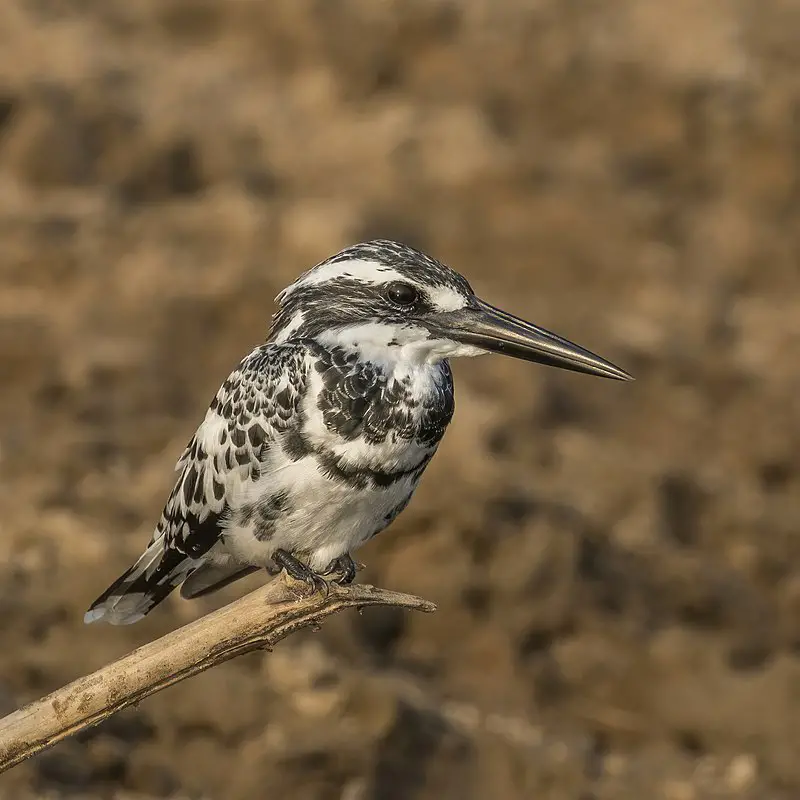
The Pied Kingfisher is a species of water kingfisher found in Africa and Asia. It has black and white plumage, with males sporting a double band across the breast while females have one single band.
This bird makes its presence known by hovering over clear waters before diving for fish – making it easily recognizable.
The diet consists mostly of small aquatic animals such as frogs, crustaceans and insects, but they also consume some plant matter like seeds or fruits occasionally.
The pied kingfisher nests near bodies of water where it can feed off smaller creatures that dwell there; usually in burrows dug into riverbanks or on floating vegetation close to shorelines.
With their distinct colors and behavior patterns these birds make an interesting addition to any wildlife enthusiast’s list.Scientific classification:
| Kingdom | Animalia |
| Phylum | Chordata |
| Class | Aves |
| Order | Coraciiformes |
| Family | Alcedinidae |
| Subfamily | Cerylinae |
| Genus | Ceryle F. Boie, 1828 |
| Species | C. rudis |
Also Featured In: Native Pakistani Birds, Lebanon Birds Live in Semi-Desert Areas
2. Hamerkop
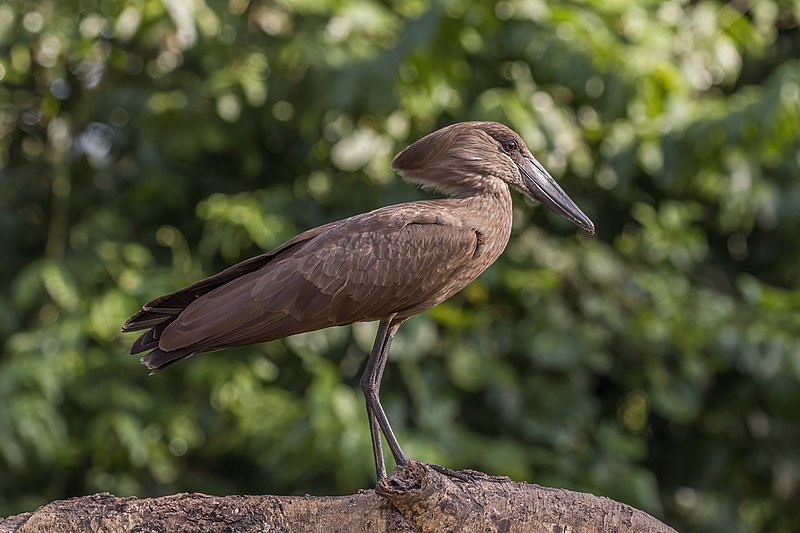
The Hamerkop is a unique wading bird found across sub-Saharan Africa and as far east as India.
It has an unmistakable silhouette, with its long bill topped by a crest at the back of its head that gives it the look of a hammerhead shark.
Its plumage consists mainly of browns and greys, providing excellent camouflage in reed beds.
The species was once classified alongside storks but is now believed to be closely related to pelicans and shoebills instead.
This medium-sized bird feeds on insects, fish, frogs or small reptiles which it captures from shallow water or plucks from trees near bodies of water.
Despite being considered ‘unlucky’ by some cultures due to superstition surrounding their appearance they are actually quite important for controlling populations of certain pests.Scientific classification:
| Kingdom | Animalia |
| Phylum | Chordata |
| Class | Aves |
| Order | Pelecaniformes |
| Family | Scopidae |
| Genus | Scopus |
| Species | S. umbretta |
Also Featured In: Common Nigerian Birds, Chad Birds You Didn’t Know
3. African Grey Hornbill
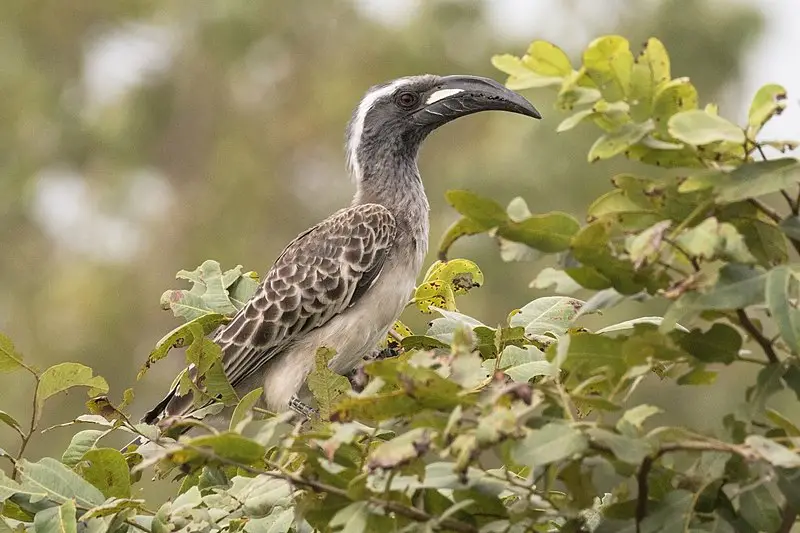
The African grey hornbill is a large bird with striking black and white plumage. Its most recognizable feature is its long, down-curved bill which has a red base and yellow tip.
They are found in sub-Saharan Africa as well as Arabia and have been known to escape or be released into Florida where they may not be breeding yet.
Their diet mainly consists of fruits, insects, small reptiles and amphibians making them important seed dispersers for their habitats.
Hornbills play an important role in the ecosystem by controlling pests like locusts while also providing food for predators such as eagles or larger cats.
These birds are often kept as pets but can become very demanding due to their intelligence so potential owners should do research before considering one of these amazing creatures.Scientific classification:
| Kingdom | Animalia |
| Phylum | Chordata |
| Class | Aves |
| Order | Bucerotiformes |
| Family | Bucerotidae |
| Genus | Lophoceros |
| Species | L. nasutus |
4. Lilac-Breasted Roller
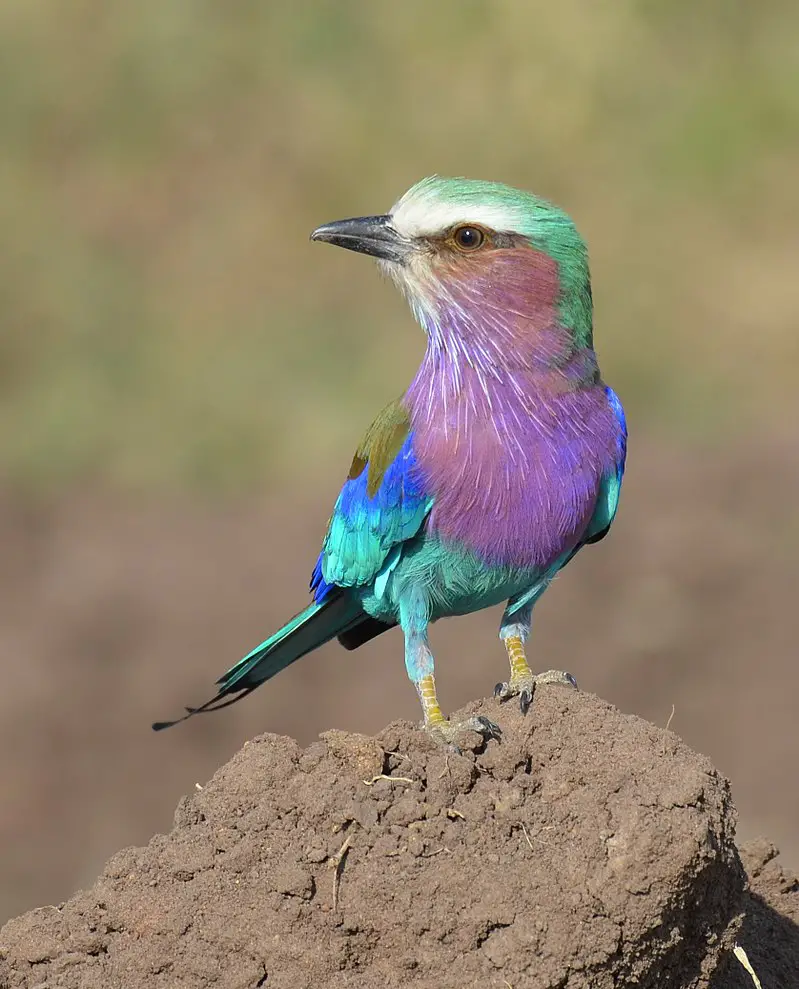
The Lilac-breasted Roller is a spectacular bird native to Southern and Eastern Africa, with occasional appearances in the southern Arabian Peninsula.
With its bright purple chest plumage and distinct black stripes on its wings and tail feathers, it stands out among birds of the same family.
It is usually found alone or in pairs perched atop trees or other high viewpoints, often used as lookout points for predators.
This species prefers open areas such as woodlands and savannas; it avoids treeless places like deserts due to their lack of protection from potential dangers.
Its call is loud and melodious – an unmistakable sound echoing through African skies.Scientific classification:
| Kingdom | Animalia |
| Phylum | Chordata |
| Class | Aves |
| Order | Coraciiformes |
| Family | Coraciidae |
| Genus | Coracias |
| Species | C. caudatus |
Also Featured In: Birds of Tanzania, Famous Paintings Birds
5. Kori Bustard
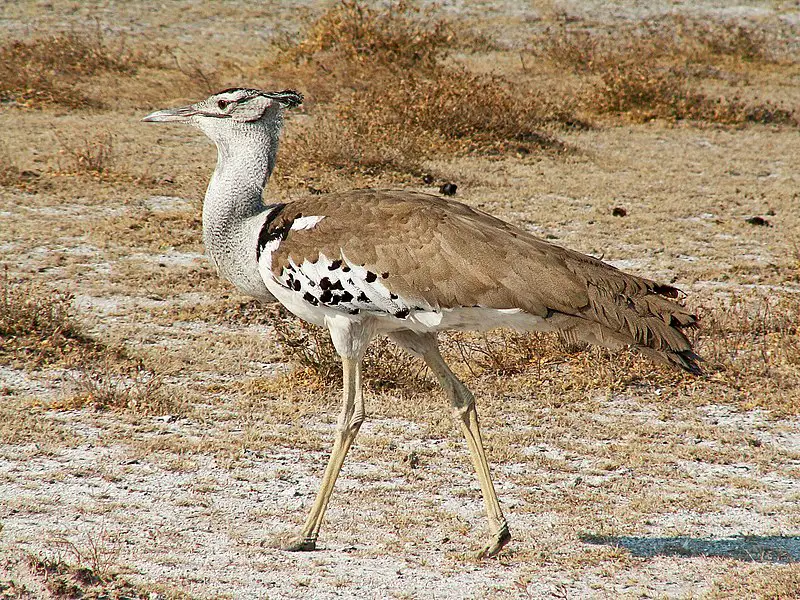
The Kori Bustard is the largest flying bird native to Africa and part of the bustard family. It has a large body, with males reaching up to 20kg in weight – making it one of the heaviest living animals capable of flight.
Its range covers most African countries from Ethiopia all the way down south towards South Africa.
The Kori Bustard is omnivorous and feeds on insects, small lizards, seeds, fruit and even carrion if available.
Their feathers are mostly brownish grey while their heads have black stripes running over them which makes them easily identifiable when seen in its natural habitat.
They usually live alone or in pairs during breeding season but will gather into larger groups at other times throughout their lives; typically nesting on dry open grasslands near water sources for easy access to food and drink.Scientific classification:
| Kingdom | Animalia |
| Phylum | Chordata |
| Class | Aves |
| Order | Otidiformes |
| Family | Otididae |
| Genus | Ardeotis |
| Species | A. kori |
Also Featured In: Large African Birds You Need to Know, Big Birds that Live in Uganda
6. Tawny Eagle
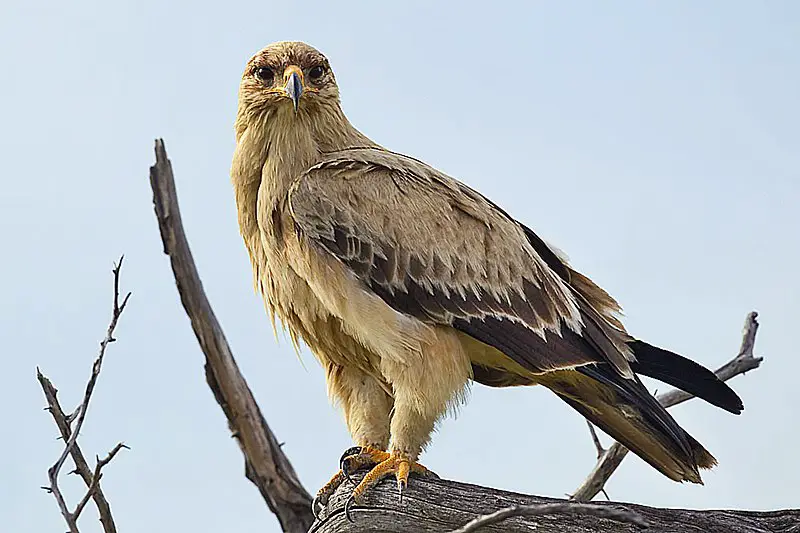
The tawny eagle is a majestic bird of prey that can be found across much of Africa, the Indian subcontinent and rare parts of southern Europe.
It belongs to the Accipitridae family, within the Aquilinae or “booted eagles” subfamily due to its heavily feathered legs.
They have brown plumage with paler underparts which gives them their namesake tawny colouring.
With long wingspans they soar gracefully over open grasslands and deserts in search of small mammals such as hares, rodents and birds for food.
Their loud squawks echo across their habitats while they use powerful talons to snatch up unsuspecting animals below them before enjoying their meal on an exposed perch high above ground level.Scientific classification:
| Kingdom | Animalia |
| Phylum | Chordata |
| Class | Aves |
| Order | Accipitriformes |
| Family | Accipitridae |
| Genus | Aquila |
| Species | A. rapax |
Also Featured In: Large Birds of Uganda,
7. Yellow-Billed Stork
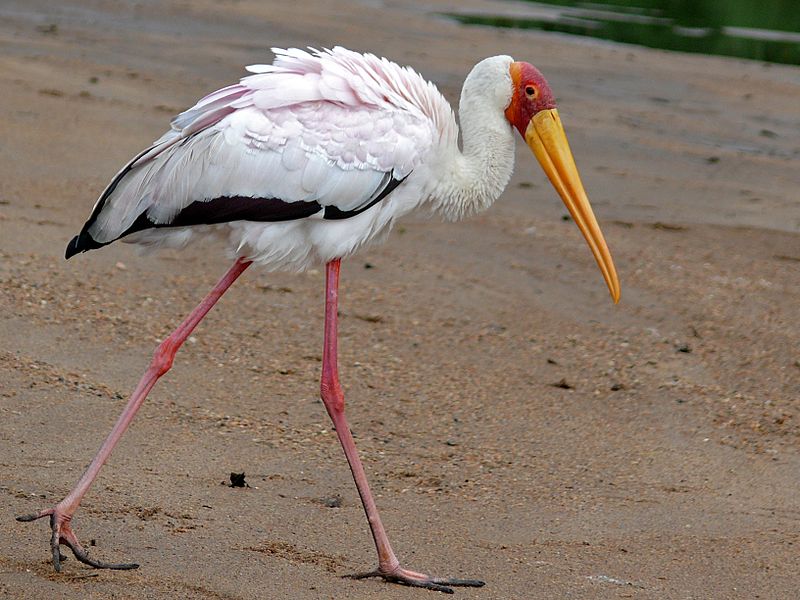
The yellow-billed stork is a large wading bird found in Africa south of the Sahara as well as Madagascar.
It belongs to the family Ciconiidae and has three other species in its genus – Mycteria americana, Mycteria cinerea and Leptoptilos javanicus.
This majestic bird stands at an average height of up to 1 meter with a wingspan that can reach 2 meters wide.
Its plumage is predominantly white with black flight feathers that contrast against its bright yellow bill for which it is named after.
The Yellow-billed Stork feeds on fish, frogs, insects and small reptiles like snakes by probing deep into mud or shallow water bodies using its long beak.
These captivating birds are also known to form colonies during their nesting season from August until October where they build nests out of sticks atop tall trees near wetlands or riversides.Scientific classification:
| Kingdom | Animalia |
| Phylum | Chordata |
| Class | Aves |
| Order | Ciconiiformes |
| Family | Ciconiidae |
| Genus | Mycteria |
| Species | M. ibis |
Also Featured In: Fuerteventura Island Birds You Need to See,
8. White-Fronted Bee-Eater
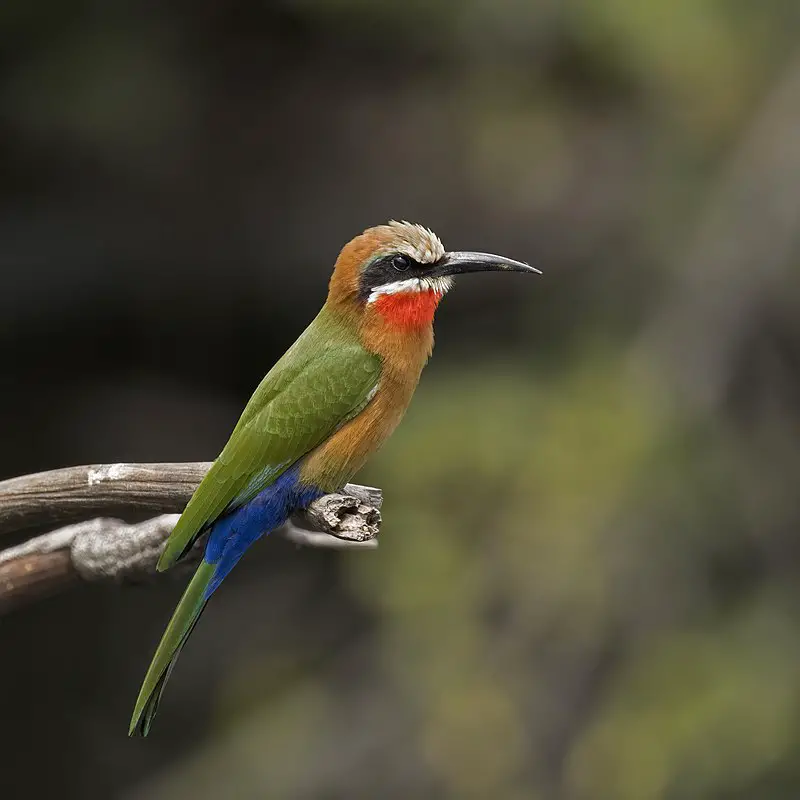
The White-fronted Bee-eater is a beautiful bird native to subequatorial Africa. It has an unmistakable white forehead, square tail and bright red throat patch that sets it apart from other species of bee eaters.
These birds typically nest in colonies by digging holes into cliffs or earthen banks near waterbodies.
During the day they can be seen perched on low trees waiting for passing insects which they swoop down upon with great agility to capture their prey midair.
They may also hover around flowers while searching for food – making them quite a sight to behold indeed.
All in all, these majestic creatures are truly fascinating to observe and make wonderful additions to any natural habitat.Scientific classification:
| Kingdom | Animalia |
| Phylum | Chordata |
| Class | Aves |
| Order | Coraciiformes |
| Family | Meropidae |
| Genus | Merops |
| Species | M. bullockoides |
9. White-Backed Vulture
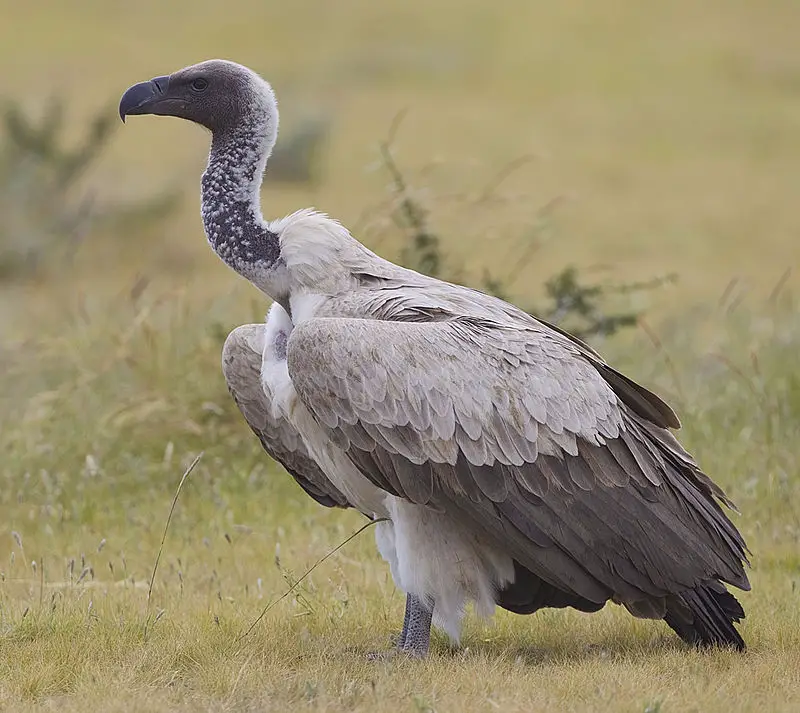
The White-backed Vulture, or Gyps africanus, is a species of Old World vultures that inhabits the African continent.
It has distinct features including down feathers on its head and neck as well as white ruff around its neck. Its wings are broad and its tail short.
This distinctive bird is primarily found in open habitats such as grasslands, savannahs, woodlands and wetlands where it feeds mainly on carrion from animals like wildebeests and zebras killed by other predators.
The White-backed Vulture plays an important role in maintaining balance within the food chain by helping to clean up carcasses left behind by larger carnivores which helps to reduce diseases caused by decaying matter while providing vital nutrients for scavenging birds like itself.Scientific classification:
| Kingdom | Animalia |
| Phylum | Chordata |
| Class | Aves |
| Order | Accipitriformes |
| Family | Accipitridae |
| Genus | Gyps |
| Species | G. africanus |
Also Featured In: Scavengers Birds You Should Know,
10. Malachite Kingfisher
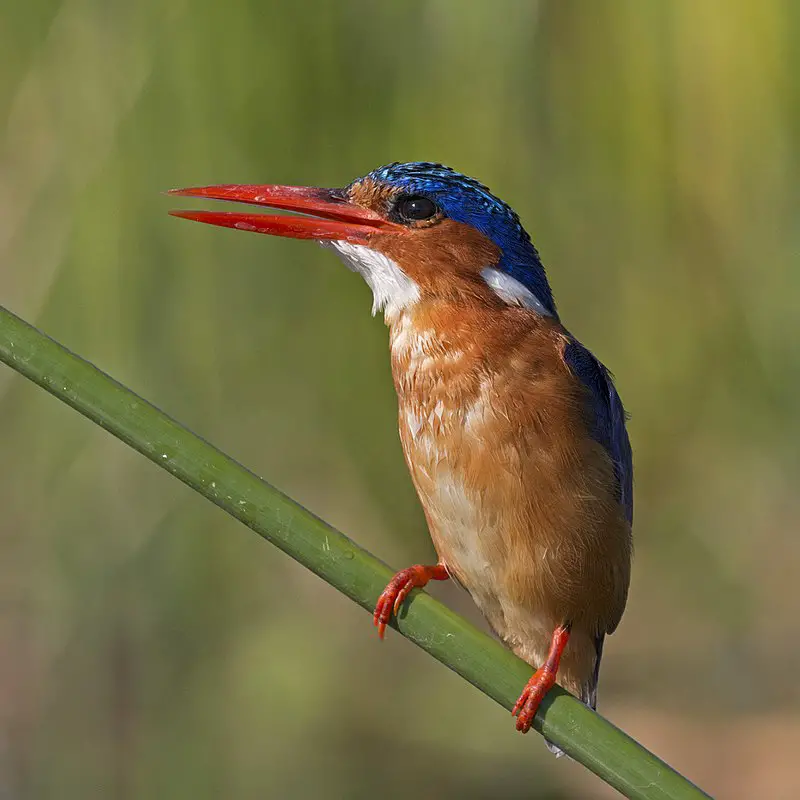
The Malachite Kingfisher is a beautiful bird found in Africa south of the Sahara. It has bright blue wings and tail, with greenish-black upperparts, white chin and breast and orange lower belly.
The species was first described by German naturalist Peter Simon Pallas in 1764 who gave it its binomial name “Alcedo cristata”.
This kingfisher typically inhabits rivers where it feeds on fish, frogs as well as aquatic invertebrates like crustaceans and insects.
Although mainly resident throughout the year, some do make seasonal movements due to climate changes.
These birds are monogamous during breeding season which usually lasts from August till October when they build their nests inside river banks or overhanging vegetation near water bodies.Scientific classification:
| Kingdom | Animalia |
| Phylum | Chordata |
| Class | Aves |
| Order | Coraciiformes |
| Family | Alcedinidae |
| Subfamily | Alcedininae |
| Genus | Corythornis |
| Species | C. cristatus |
Also Featured In: Birds that Live in lake Mburo National Park,
11. White-Browed Coucal
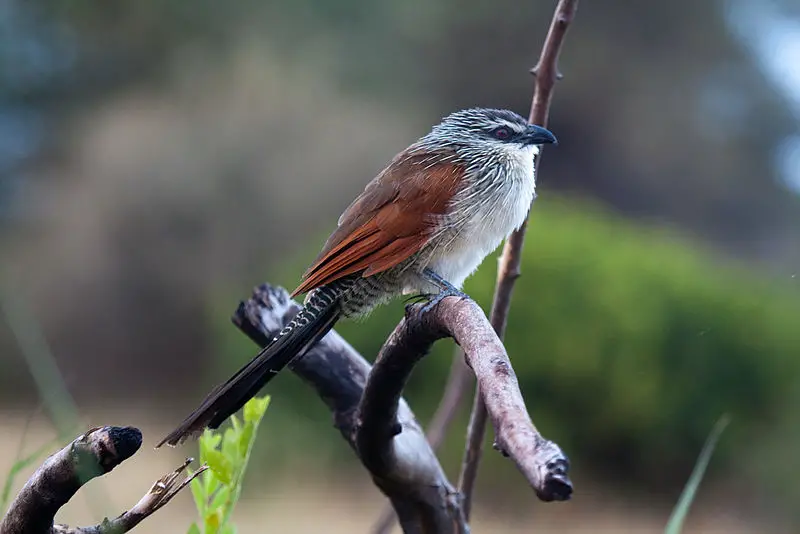
The White-browed Coucal is a species of bird belonging to the Cuculidae family. It can be found in sub-Saharan Africa, inhabiting thick vegetation and rank undergrowth as well as coastal regions.
This medium-sized cuckoo has a length between 36 and 42 cm and is sometimes considered a subspecies of Burchell’s coucal.
Its main distinguishing feature is its white eyebrow which extends towards the back of its head, giving it an elegant look that makes it stand out from other birds in its habitat.
Additionally, this species also features black plumage with some yellow spots on their wings and tail feathers for extra beauty points.
All in all, these fascinating creatures make great additions to any wildlife enthusiast’s list of spotted animals.Scientific classification:
| Kingdom | Animalia |
| Phylum | Chordata |
| Class | Aves |
| Order | Cuculiformes |
| Family | Cuculidae |
| Genus | Centropus |
| Species | C. superciliosus |
Also Featured In: Birds of South African, Birds of KwaZulu-Natal
12. Southern Yellow-Billed Hornbill
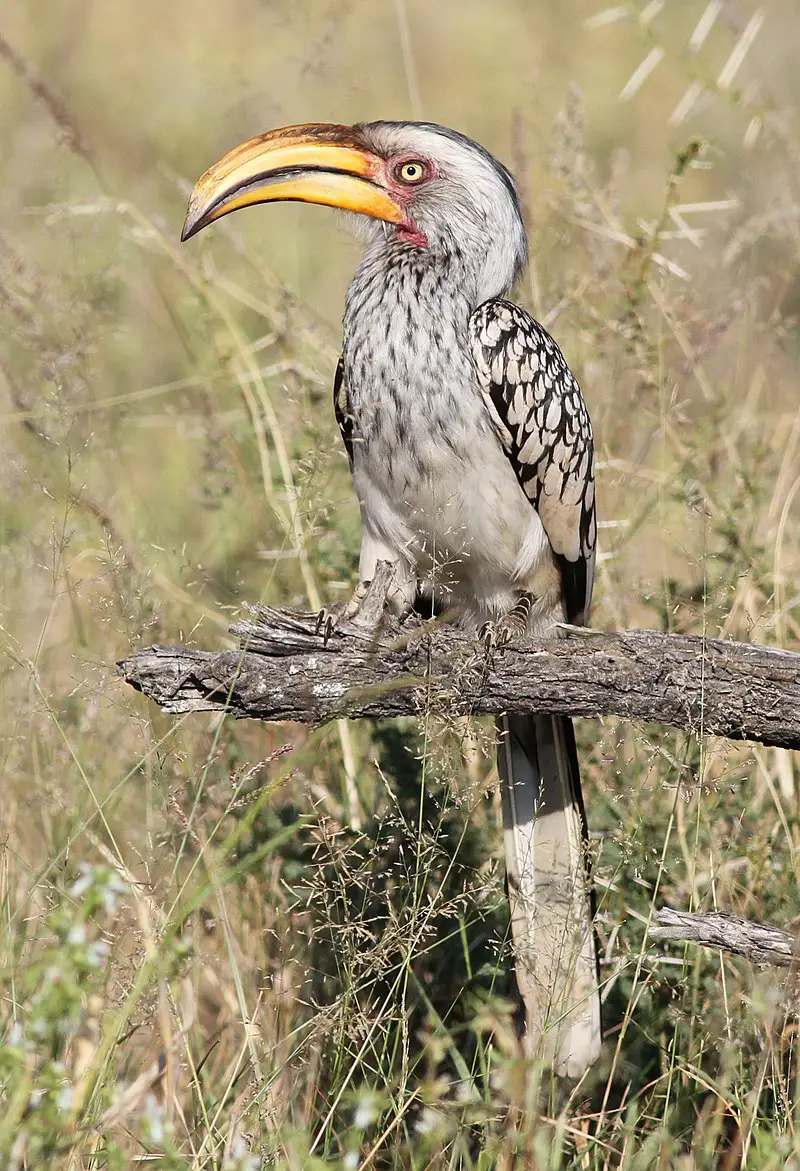
The Southern yellow-billed hornbill is a species of medium sized bird found in southern Africa. It feeds mainly on the ground, foraging for seeds, insects, spiders and scorpions.
These birds are quite common and can be seen along roadsides and water courses due to their preference of dry thornveldt as well as broad-leafed woodlands.
They have bright yellow bills which make them easily recognizable among other birds.
The average length of these beautiful creatures range between 40 – 48 cm with an impressive wingspan reaching up to 90 cm wide.
This stunning species is considered vulnerable by IUCN since it’s numbers are slowly declining due to hunting activities and habitat destruction from urbanization.Scientific classification:
| Kingdom | Animalia |
| Phylum | Chordata |
| Class | Aves |
| Order | Bucerotiformes |
| Family | Bucerotidae |
| Genus | Tockus |
| Species | T. leucomelas |
13. Saddle-Billed Stork
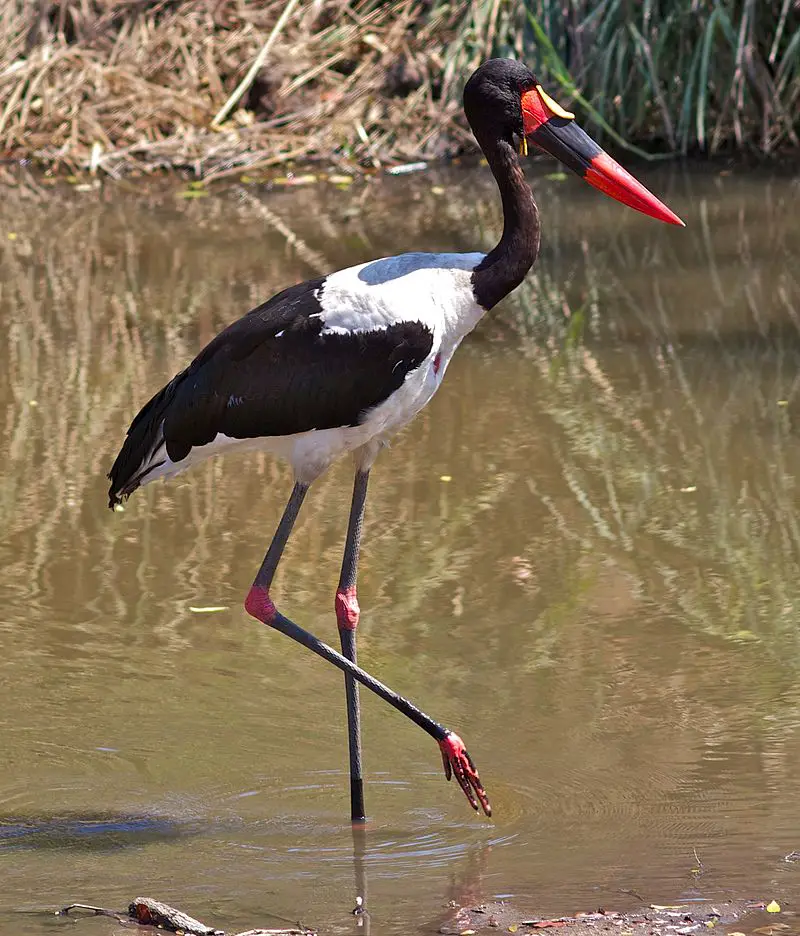
The Saddle-billed Stork is a large wading bird from the stork family, Ciconiidae. It can be found in sub-Saharan Africa and some parts of western Africa.
This majestic bird stands out with its striking features – it has an impressive bill that looks like a saddle and bright red legs which contrast against its white plumage on top.
The Saddle-billed Stork’s diet consists mostly of fish, frogs, aquatic invertebrates as well as small reptiles or mammals they come across while scavenging for food in wetland areas.
Sadly, this species is considered endangered in South Africa due to habitat loss and degradation caused by human activities such as drainage projects and agricultural expansion.
We must take action to protect these beautiful creatures before their numbers decrease further.Scientific classification:
| Kingdom | Animalia |
| Phylum | Chordata |
| Class | Aves |
| Order | Ciconiiformes |
| Family | Ciconiidae |
| Genus | Ephippiorhynchus |
| Species | E. senegalensis |
Also Featured In: Birds You’ll Find in Zoo,
14. African Green Pigeon
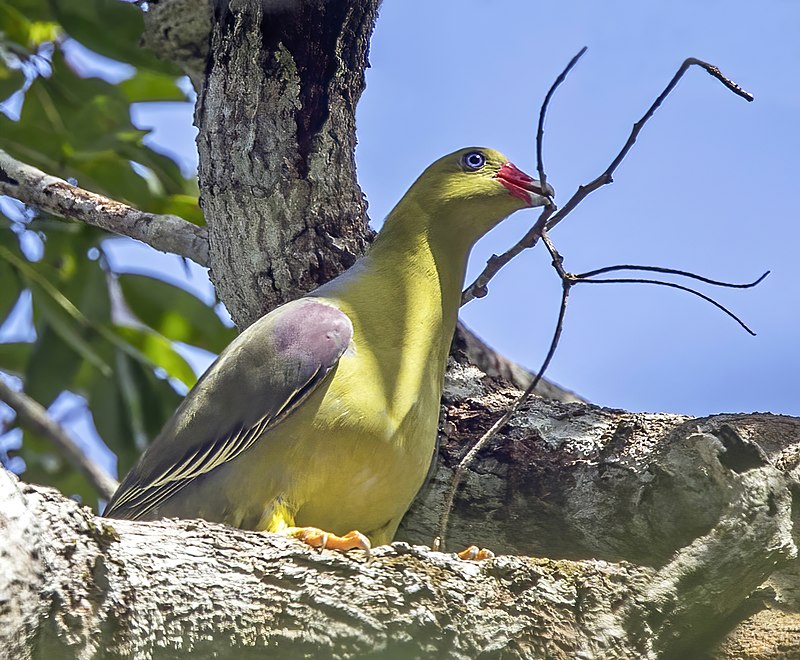
The African green pigeon is an incredibly unique bird that inhabits the Sub-Saharan Africa region.
It has a wide range of accepted races, and its adults have maroon patches on their wings while juveniles are olive in color.
Its upperparts can be grayish-green to yellowish-green with a white throat, barred underparts and clean legs. This species feeds mainly on fruit but may also consume seeds or insects.
It typically nests in trees near water or swamps where it builds platforms made from twigs for laying eggs which hatch after 2 weeks of incubation period by both parents sharing the duties equally .
The African green pigeon is quite vocal during mating season as well as when alarmed; often using whistles “kiu” notes to communicate with each other in flocks up to 30 birds at a time.Scientific classification:
| Kingdom | Animalia |
| Phylum | Chordata |
| Class | Aves |
| Order | Columbiformes |
| Family | Columbidae |
| Genus | Treron |
| Species | T. calvus |
15. Lappet-Faced Vulture
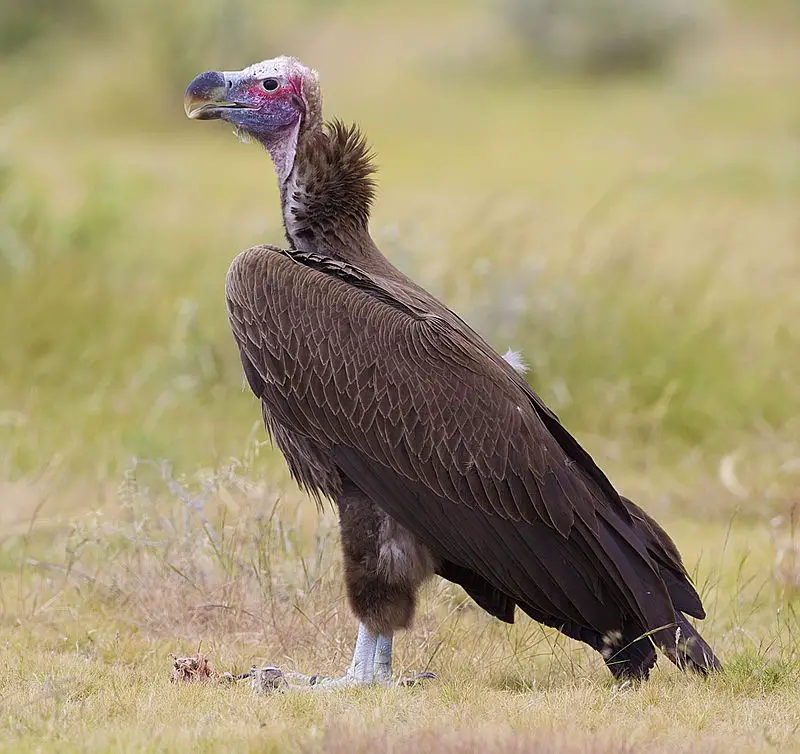
The Lappet-faced Vulture is a large bird of prey belonging to the Accipitriformes order. It has an unmistakable look, with its bare head and neck, white body and brown wings.
This species is native to Africa where it can be found in very dry areas such as deserts or semi-deserts. They feed mainly on carrion but they also eat small animals like lizards or rodents if needed.
Their strong bill helps them tear through tough hides while their long legs help them find food easier by allowing them to walk around looking for it instead of relying solely on soaring high up into the sky like other vultures do to locate carcasses from afar.
The Lappet-faced Vulture plays a crucial role in cleaning up carcasses which otherwise would spread diseases quickly throughout African ecosystems.Scientific classification:
| Kingdom | Animalia |
| Phylum | Chordata |
| Class | Aves |
| Order | Accipitriformes |
| Family | Accipitridae |
| Genus | Torgos Kaup, 1828 |
| Species | T. tracheliotos |
Also Featured In: Common Kenyan Birds, Endemic Ethiopian Birds You don’t Know
16. Southern Ground Hornbill
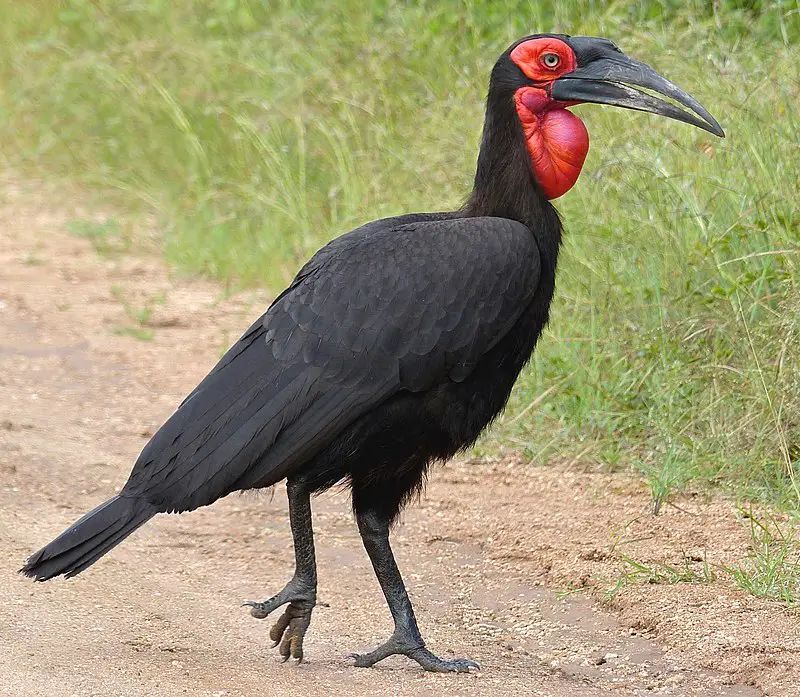
The Southern Ground Hornbill is a majestic bird, native to the southern regions of Africa such as Kenya and South Africa. It inhabits both woodlands and savannas where it can be found in abundance.
These birds are quite large, making them the largest species within their order worldwide. They have striking black feathers with red patches on their neck and wings which make for an impressive sight when taking flight.
A unique feature of these birds is that they form long-term pairs or family groups; usually consisting of two adults plus several helper offspring from previous years who assist in raising new young chicks together.
This amazing creature’s powerful presence remains unchanged throughout its range – reminding us why conservation efforts must persist if we want this incredible bird to remain part of our planet’s diverse wildlife heritage for centuries to come.Scientific classification:
| Kingdom | Animalia |
| Phylum | Chordata |
| Class | Aves |
| Order | Bucerotiformes |
| Family | Bucorvidae |
| Genus | Bucorvus |
| Species | B. leadbeateri |
17. Senegal Coucal
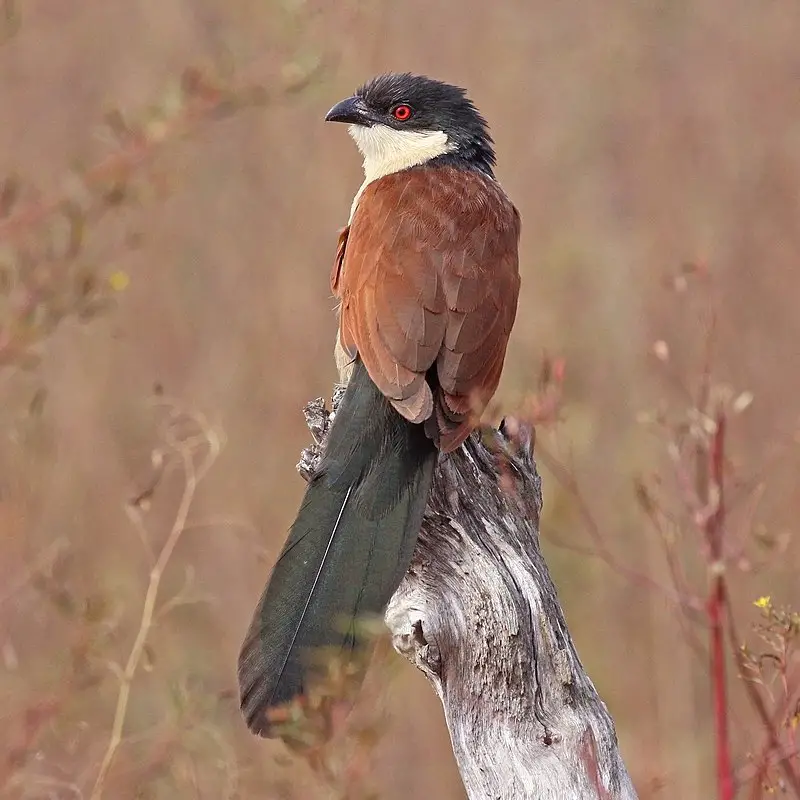
The Senegal coucal is a cuckoo-like bird native to Central and Southern Africa. It has a medium-sized body with black wings, tail and head along with white breast feathers.
Its natural habitat consists of lightly wooded savannahs where it feeds on insects, small reptiles, amphibians and fruits.
This species can be found in pairs or alone atop low bushes searching for prey or perched up high singing its distinctive song that features a mix of harsh notes as well as melodic ones.
The Senegal coucal enjoys the sun’s rays but also loves sheltering in dense vegetation when danger arises nearby.
Overall this beautiful bird makes an interesting addition to any backyard garden.Scientific classification:
| Kingdom | Animalia |
| Phylum | Chordata |
| Class | Aves |
| Order | Cuculiformes |
| Family | Cuculidae |
| Genus | Centropus |
| Species | C. senegalensis |
Also Featured In: Birds that Live in Benin,
18. Yellow-Billed Oxpecker
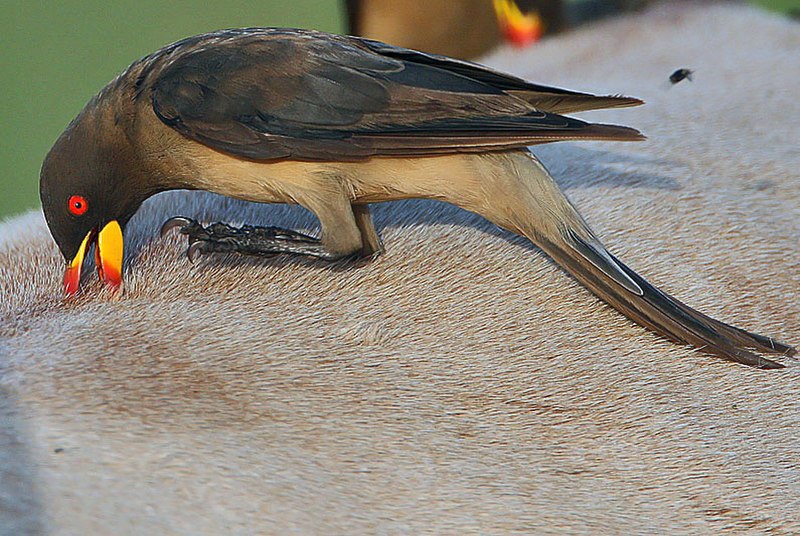
The Yellow-billed Oxpecker is a passerine bird native to the savannahs of Sub-Saharan Africa. It was previously placed in the starling and myna family, Sturnidae.
These birds are characterized by their bright yellow bills, which give them their name.
They feed mainly on insects found on large mammals such as wildebeests and zebras, but also consume fruits from nearby trees or shrubs when available.
The species tends to dominate over its smaller relative -the Red-billed oxpecker – whenever they share feeding grounds together; although it is least common in eastern parts of its range where they overlap with each other’s territories.
All in all, this beautiful avian creature makes for an interesting sight while exploring the African Savannah.Scientific classification:
| Kingdom | Animalia |
| Phylum | Chordata |
| Class | Aves |
| Order | Passeriformes |
| Family | Buphagidae |
| Genus | Buphagus |
| Species | B. africanus |
Also Featured In: Uganda Birds Species, Birds that Ngorongoro Crater
19. Verreaux’s Eagle-Owl
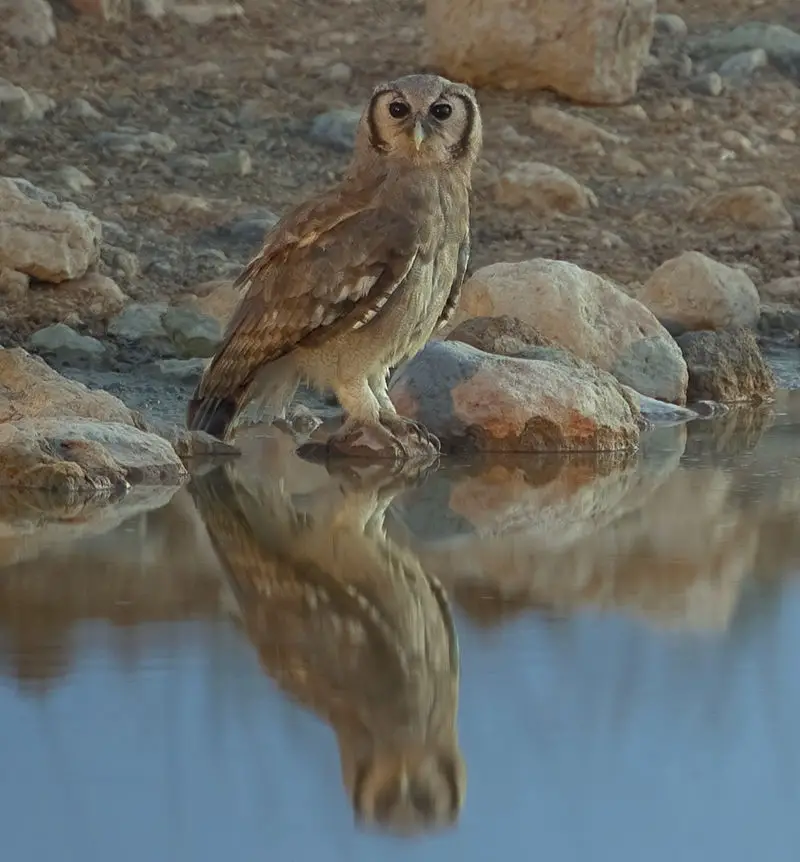
Verreaux’s eagle-owl is a magnificent bird that can be found in dry, wooded savannas of sub-Saharan Africa. It is the largest African owl and measures up to 66 cm (26 inches) long.
This majestic creature has grey plumage with white spots on its back and wings, while its face is covered by an impressive facial disk.
Its eyes are yellowish orange in color, surrounded by white feathers which give it a striking appearance.
These birds hunt mostly during the night but may occasionally also do so during daylight hours when food becomes scarce or if they have recently hatched young ones who need feeding.
Verreaux’s eagle-owls live alone or in pairs for much of the year until breeding season comes around after which two eggs will be laid at once and incubated for about 30 days before hatching into fluffy chicks.Scientific classification:
| Kingdom | Animalia |
| Phylum | Chordata |
| Class | Aves |
| Order | Strigiformes |
| Family | Strigidae |
| Genus | Bubo |
| Species | B. lacteus |
20. Black-Hooded Oriole
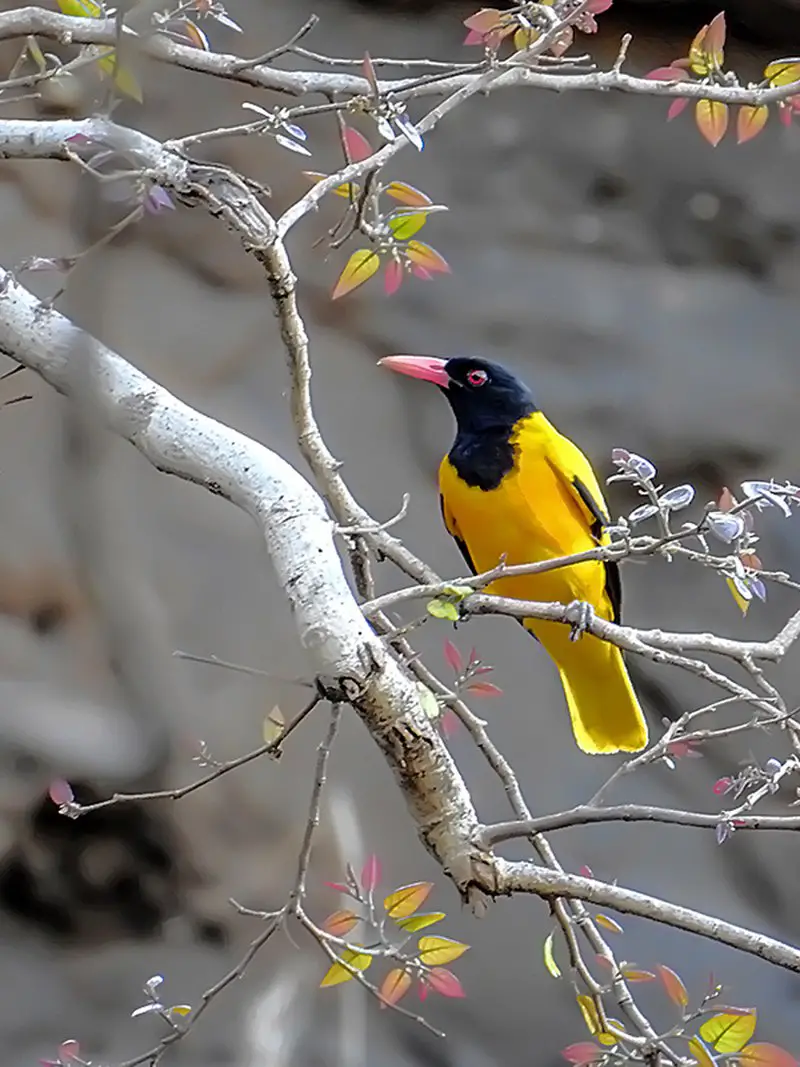
The Black-hooded Oriole is a beautiful and unique bird found in tropical southern Asia. It has black feathers on its head, giving it the name “black hooded”.
Its diet consists of insects, fruit, especially figs which can be found in the tree canopy where they spend most of their time. They build nests high up on trees to lay their eggs – usually two per nest.
The orioles are active during daybreak and nightfall when they search for food or mates. Their bright colors make them noticeable even from afar making them an interesting sight for any nature lover with a keen eye.Scientific classification:
| Kingdom | Animalia |
| Phylum | Chordata |
| Class | Aves |
| Order | Passeriformes |
| Family | Oriolidae |
| Genus | Oriolus |
| Species | O. xanthornus |
Also Featured In: Common Birds Found in Nepal, Birds of Goa
21. Green Wood Hoopoe
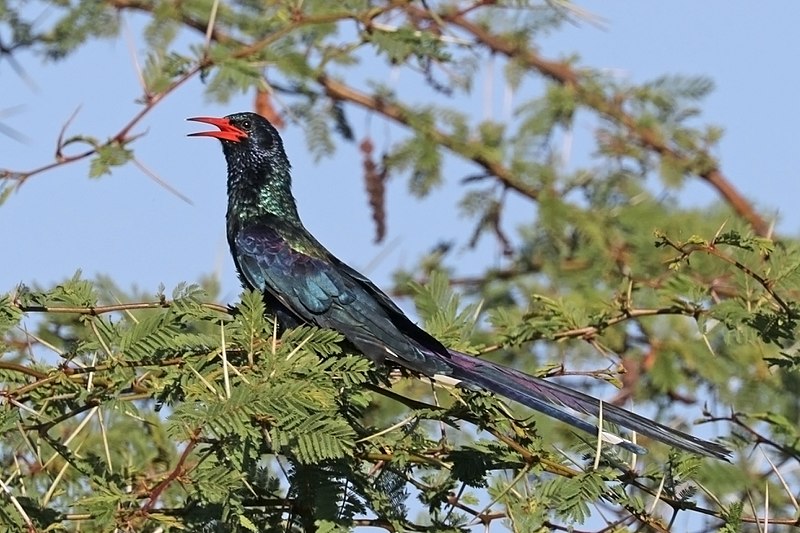
The Green wood hoopoe is a beautiful species of bird native to Africa. It measures up to 44 cm in length, and has distinctively bright green feathers with a purple back and long tail.
Its wings are marked with white, adding further distinction to this vibrant creature.
This abundant species can be found living among the trees of tropical forests across its range – it gets its name from their habit of using sticks and twigs for nest building purposes.
The Green wood hoopoe enjoys eating insects such as beetles, crickets, grasshoppers, moths and caterpillars; they also feed on small reptiles like lizards or snakes when available.
They are known for their loud call which sounds much like “oop-oop” echoing through the forest canopy – making them quite easy to spot.Scientific classification:
| Kingdom | Animalia |
| Phylum | Chordata |
| Class | Aves |
| Order | Bucerotiformes |
| Family | Phoeniculidae |
| Genus | Phoeniculus |
| Species | P. purpureus |
Also Featured In: Most Unique Birds in Niger,
22. Pearl-Spotted Owlet
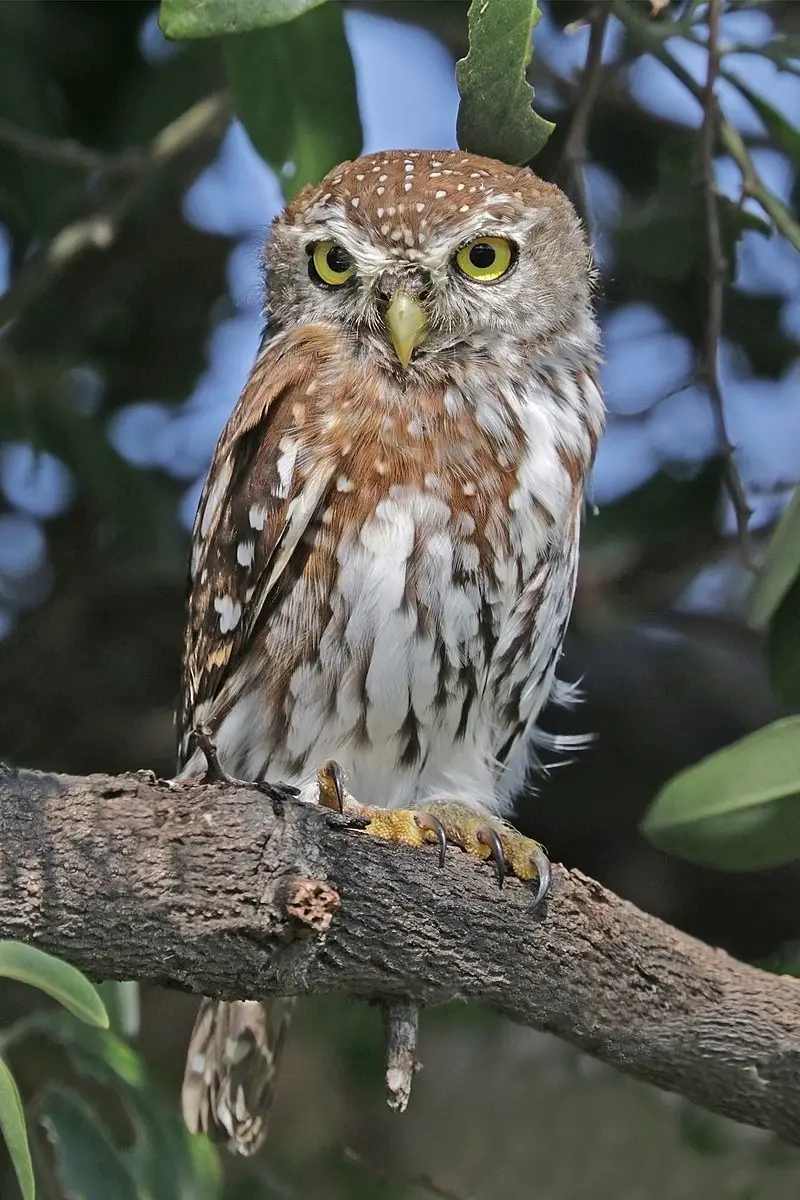
The Pearl-spotted Owlet is a small bird of prey that lives in sub-Saharan Africa. It belongs to the Strigidae family, which are commonly referred to as typical owls or true owls.
These birds have brown feathers with heavy spots, making them easily recognizable among other species of owl.
They usually measure between 14 and 16 centimeters long with an average wingspan of 28 centimeters wide.
Their diet consists mainly of insects such as moths and beetles but they also feed on frogs and small rodents occasionally.
During mating season males will use their sharp call for territorial purposes while females remain silent during this time period.
The female lays 2-4 eggs at one time before incubating them for around 3 weeks until hatching occurs after which both parents take part in feeding their young chicks until fledging age which is when they become independent enough to survive on their own in nature.Scientific classification:
| Kingdom | Animalia |
| Phylum | Chordata |
| Class | Aves |
| Order | Strigiformes |
| Family | Strigidae |
| Genus | Glaucidium |
| Species | G. perlatum |
23. Little Bee-Eater
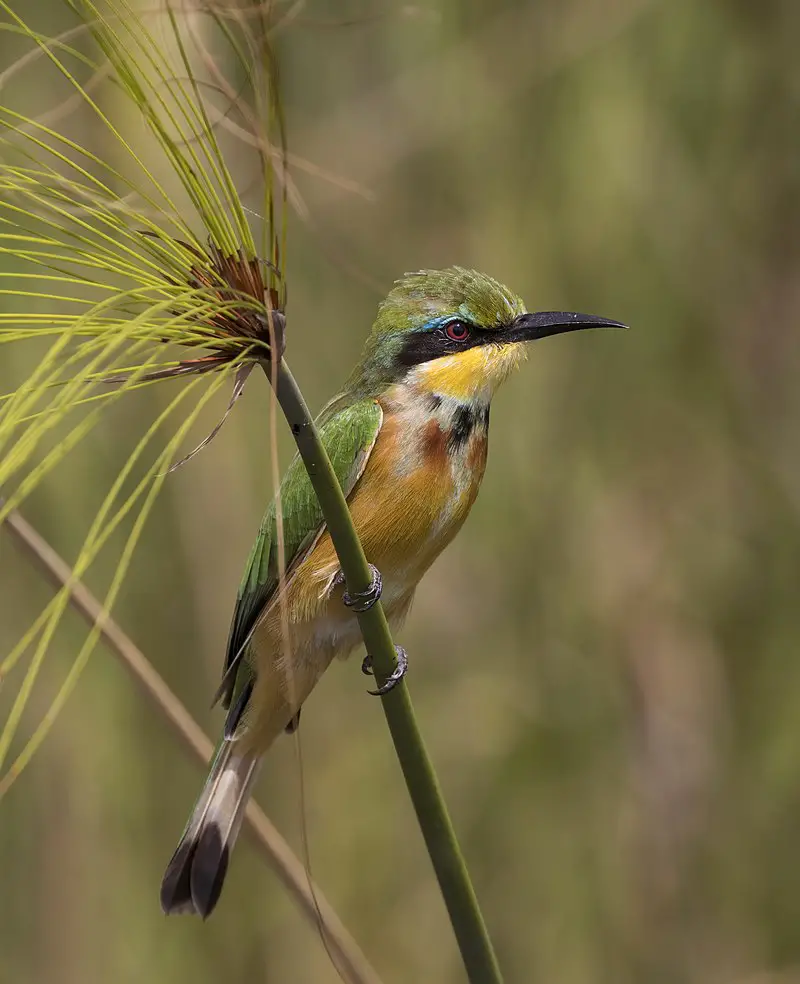
The Little Bee-eater (Merops pusillus) is a beautiful species of bird belonging to the family Meropidae.
These birds are found in much of Sub-Saharan Africa and their migration patterns depend on seasonal rainfall changes.
They have slender, brightly coloured bodies with an iridescent green sheen across the wings and back.
Their diet consists mainly of bees, wasps, dragonflies, moths and other insects which they catch mid-air or from perches above open grasslands or along mudbanks near water sources like rivers and lakes.
In order for these birds to digest their food properly before swallowing it whole, they use pebbles that help them grind up hard exoskeletons so as not to cause any blockages within their digestive tract – something only bee-eaters do.Scientific classification:
| Kingdom | Animalia |
| Phylum | Chordata |
| Class | Aves |
| Order | Coraciiformes |
| Family | Meropidae |
| Genus | Merops |
| Species | M. pusillus |
Also Featured In: Birds of Malawi,
24. African Hawk-Eagle
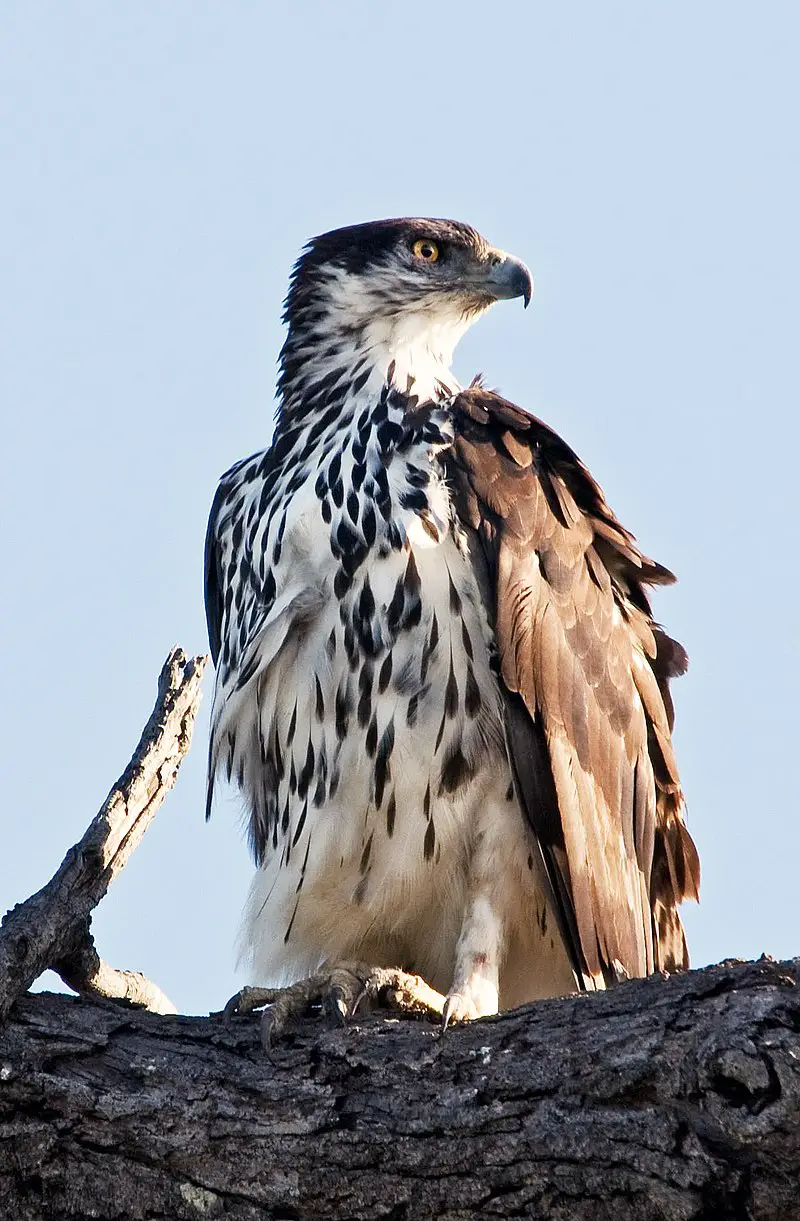
The African hawk-eagle is a majestic bird of prey belonging to the Accipitridae family. It inhabits tropical regions of Sub-Saharan Africa, and prefers dry woodlands or savannas for its habitat.
This species stands out due to its feathered legs – an adaptation which sets it apart from other members in the Aquilinae subfamily.
The eagle shows great agility while hunting with swift aerial dives, and can be seen perched atop tall trees as part of their hunting strategy.
With strong talons and sharp curved beaks they feed on small reptiles, mammals or birds such as doves and quail – making them apex predators within their ecosystem.Scientific classification:
| Kingdom | Animalia |
| Phylum | Chordata |
| Class | Aves |
| Order | Accipitriformes |
| Family | Accipitridae |
| Genus | Aquila |
| Species | A. spilogaster |
25. Tropical Boubou
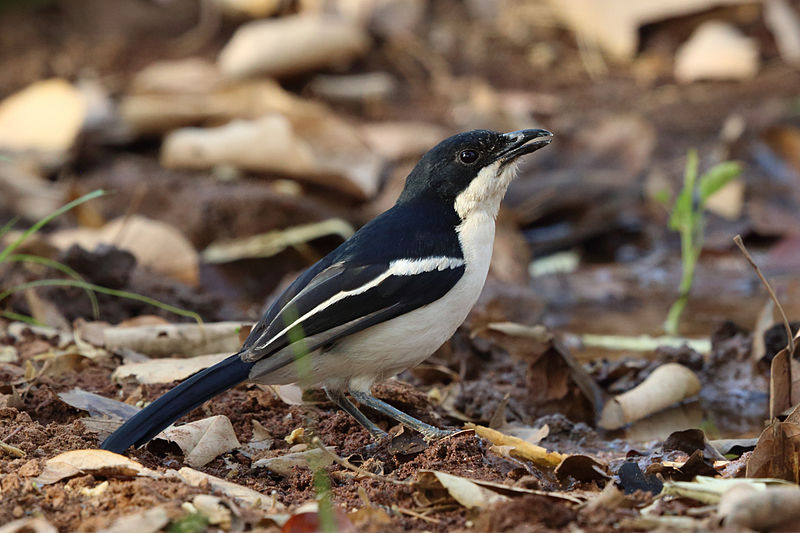
The Tropical Boubou, also known as Bell Shrike, is a medium-sized passerine bird found in sub-Saharan Africa.
It has long been considered to be a single species with numerous morphs and subspecies, however recent research suggests it actually belongs to an entire complex of different species.
They are fairly large for their family; growing up to 25 cm (10 inches) in length and weighing around 40g (1 ounce).
The males have black upper parts while the females tend to be greyish brown or olive green.
Both sexes possess white underparts with barring on the chest and wings as well as some distinctive facial patterns – one being two yellow ‘eyebrows’ over each eye.
These birds feed primarily on insects but will sometimes take fruit too.Scientific classification:
| Kingdom | Animalia |
| Phylum | Chordata |
| Class | Aves |
| Order | Passeriformes |
| Family | Malaconotidae |
| Genus | Laniarius |
| Species | L. aethiopicus |
26. Southern Carmine Bee-Eater
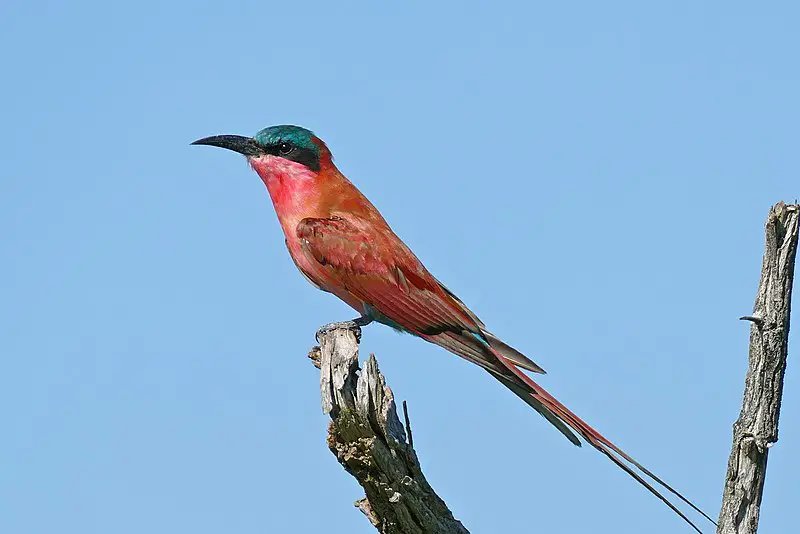
The Southern carmine bee-eater is a beautiful bird that can be found in subequatorial Africa. Its plumage is mainly carmine, but its crown and undertail are blue.
It ranges from KwaZulu-Natal and Namibia to Gabon, the eastern Democratic Republic of the Congo and Kenya.
This species feeds on insects like bees or wasps which it catches midair with acrobatic swoops while they’re flying by.
When not hunting for food these birds often gather together in large flocks before going off again to feed individually or as pairs.
They also roost communally at night near their regular feeding grounds so they can quickly return when dawn breaks.
The Southern carmine bee-eater plays an important role in controlling insect populations making them essential members of African ecosystems.Scientific classification:
| Kingdom | Animalia |
| Phylum | Chordata |
| Class | Aves |
| Order | Coraciiformes |
| Family | Meropidae |
| Genus | Merops |
| Species | M. nubicoides |
Also Featured In: Most common bird in Zambia,
27. Red-Billed Oxpecker
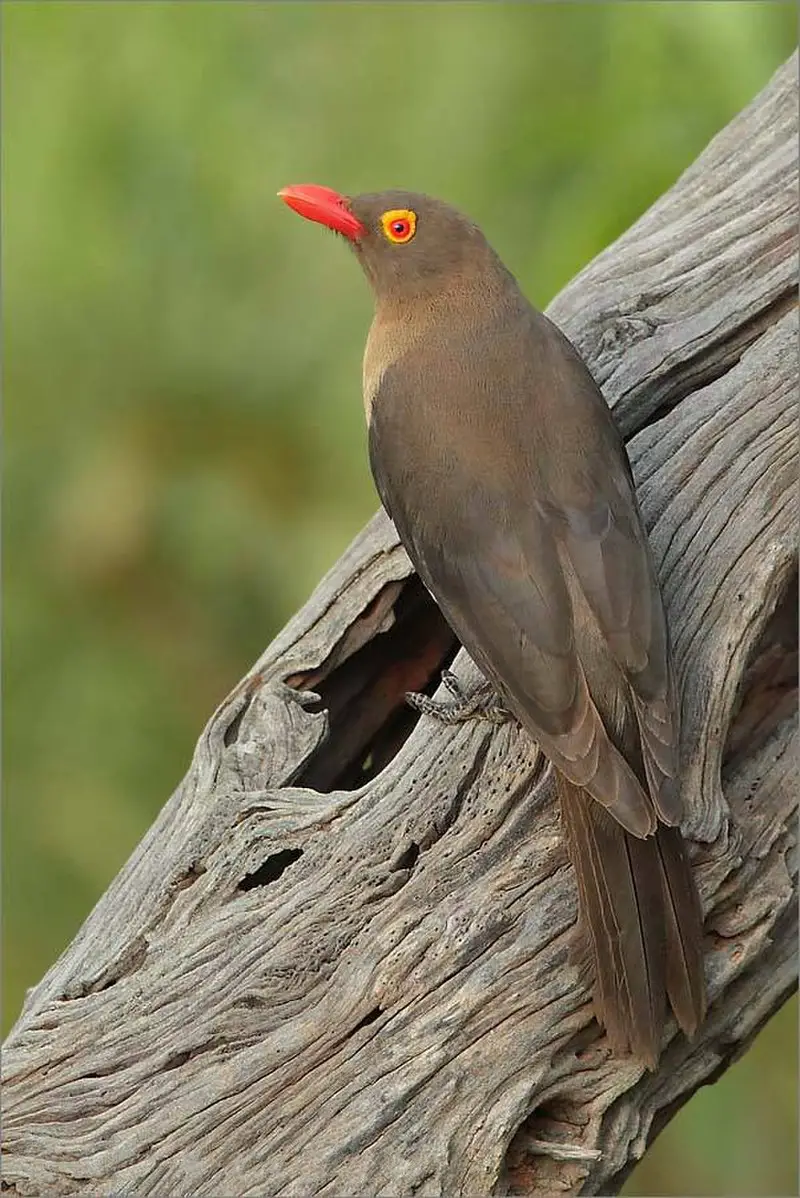
The red-billed oxpecker is a vibrant bird native to the savannas of sub-Saharan Africa. It has bright chestnut plumage, with distinctive yellow and black markings on its wings and tail.
The beak is a deep crimson color, for which it gets its name. These birds live in small flocks that often roost together at night or feed near large herds of animals such as zebra or wildebeest during the day.
They mainly eat ticks off these larger mammals but will also take advantage of any other food sources they can find such as fruits or insects.
Red-billed oxpeckers are known to have an important relationship with their prey; by removing parasites from them they help prevent diseases from spreading amongst different species in the area.Scientific classification:
| Kingdom | Animalia |
| Phylum | Chordata |
| Class | Aves |
| Order | Passeriformes |
| Family | Buphagidae |
| Genus | Buphagus |
| Species | B. erythrorynchus |
28. Giant Kingfisher
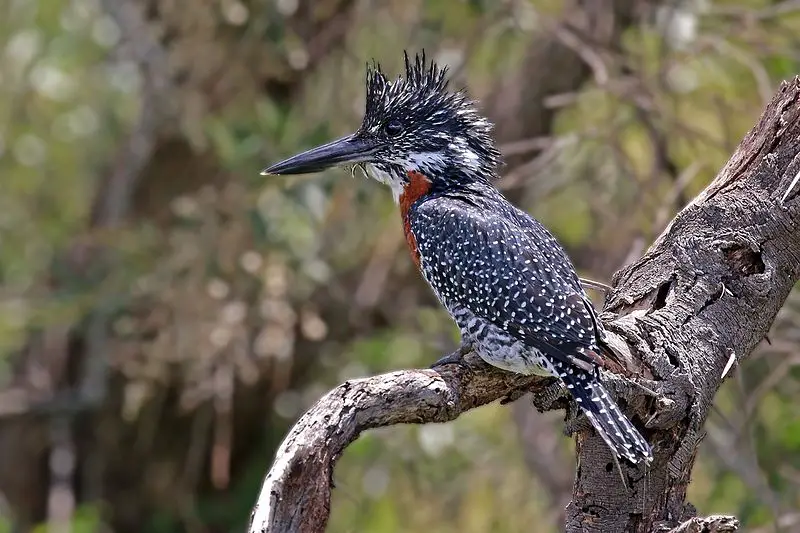
The Giant Kingfisher is the biggest of its kind in Africa, living and breeding over most parts of the continent excluding arid southwest regions.
It was first formally described by German naturalist Peter Simon Pallas back in 1769 under Alcedo maxima as its binomial name.
Subsequently, it has been placed into a new genus Megaceryle which was named by French ornithologist Louis Jean Pierre Vieillot in 1816.
This majestic bird typically measures about 40 cm (15 inches) long with predominantly blue-green plumage on top combined with white breast and belly underneath.
Its bill is large, robust and bright red or orange coloured adding to its striking beauty even further.Scientific classification:
| Kingdom | Animalia |
| Phylum | Chordata |
| Class | Aves |
| Order | Coraciiformes |
| Family | Alcedinidae |
| Subfamily | Cerylinae |
| Genus | Megaceryle |
| Species | M. maxima |
29. White-Crowned Lapwing
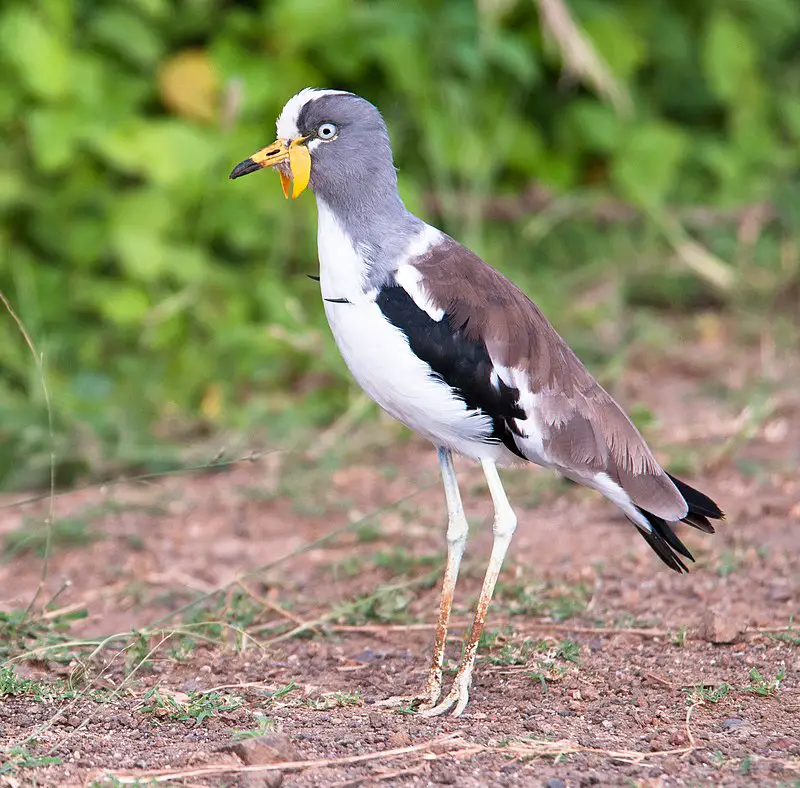
The White-crowned Lapwing is a medium sized wader found in tropical Africa near large rivers. It has distinctively patterned wings and tail with black, white, brown and grey markings on the head making it unmistakable from other lapwings.
Its crown of feathers gives this bird its name as well as adding to its unique look. This bird stands out due to its vibrant plumage which sets it apart from any other species living in the same habitat.
The White-crowned Lapwing is an impressive sight that will be sure to draw attention amongst wildlife watchers lucky enough to see one.Scientific classification:
| Kingdom | Animalia |
| Phylum | Chordata |
| Class | Aves |
| Order | Charadriiformes |
| Family | Charadriidae |
| Genus | Vanellus |
| Species | V. albiceps |
30. Grey-Headed Gull
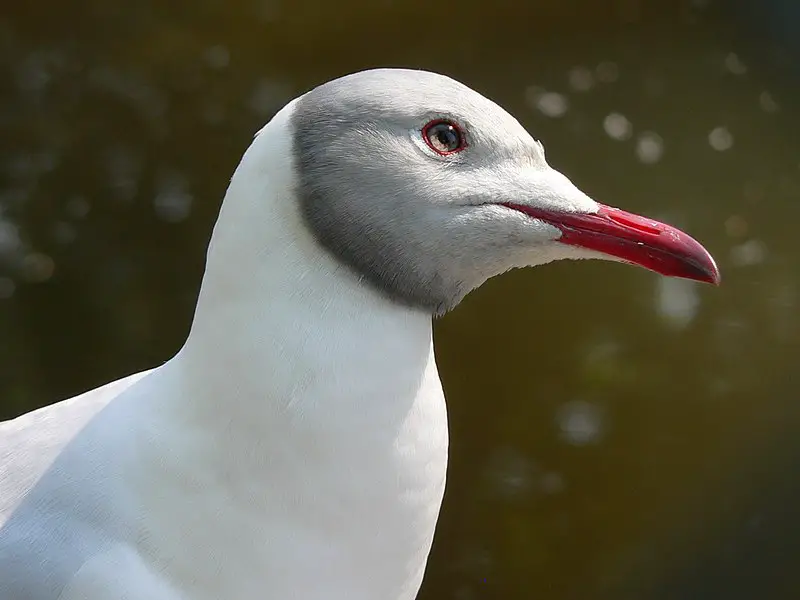
The Grey-headed Gull is a small species of gull that breeds patchily in South America and Africa south of the Sahara.
It has grey feathers on its head and wings, while its body is white with some brown spots near the tail.
This bird can be seen around coasts or inland lakes during winter times when it becomes more widespread.
Although not truly migratory, there have been rare cases where this species was recorded as a vagrant to North America, Italy and Spain.
The diet of these birds consists mainly of fish but also invertebrates such as mollusks, crustaceans and insects.
They usually forage alone or in pairs along shorelines looking for food items by probing mudflats or even stealing from other birds at times.Scientific classification:
| Kingdom | Animalia |
| Phylum | Chordata |
| Class | Aves |
| Order | Charadriiformes |
| Family | Laridae |
| Genus | Chroicocephalus |
| Species | C. cirrocephalus |
Also Featured In: Birds of Senegal, Birds That Live around Gull Rock
31. Mourning Collared Dove
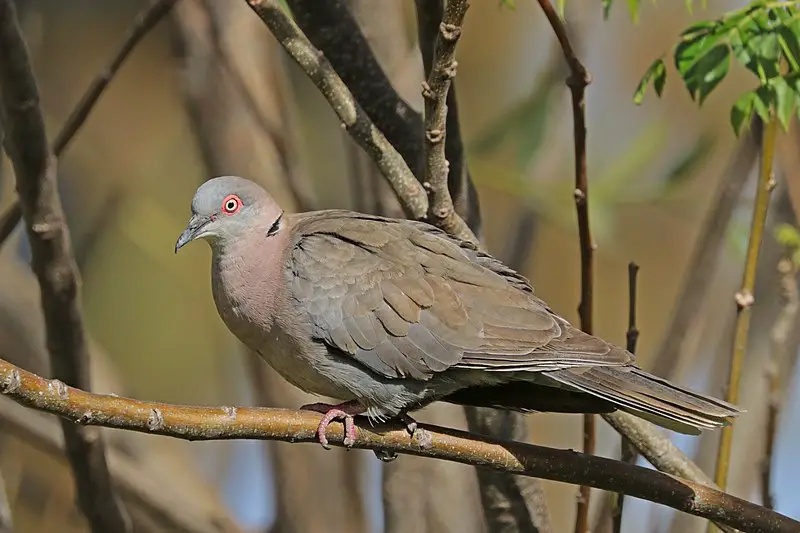
The Mourning Collared Dove is a species of dove found in Africa south of the Sahara. It is large, stocky and has distinct markings on its wings that resemble collars.
Its diet consists mainly of grains and seeds which it finds near water sources where it often mingles with other doves peacefully.
This bird makes cooing sounds as part of its courtship ritual to attract mates but also vocalises alarm calls when threatened or startled by predators.
They are widespread across their habitat range and commonly seen perched atop trees or flying about during dawn & dusk hours.
These birds make interesting avian companions for humans who appreciate their gentle nature & graceful beauty.Scientific classification:
| Kingdom | Animalia |
| Phylum | Chordata |
| Class | Aves |
| Order | Columbiformes |
| Family | Columbidae |
| Genus | Streptopelia |
| Species | S. decipiens |
Also Featured In: Birds of South Sudan,
32. African Harrier-Hawk
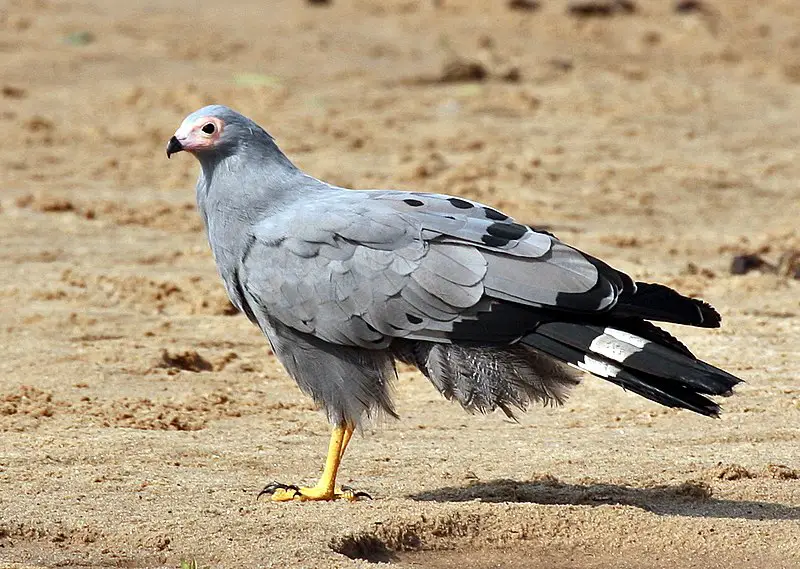
The African harrier-hawk is a medium sized bird of prey, measuring around 60 to 66 centimetres in length. It has pale grey upperparts, head and breast and its wings are broad with black primaries.
The under parts are white barred with dark brown or black stripes on the belly and thighs.
Its tail is quite long compared to other hawks, typically banded blackish above while below it’s reddish buff marked by narrow crossbars.
This species breeds mainly south of the Sahara desert in Africa but can also be found occasionally as far north as Ethiopia and Sudan during winter months when they migrate for food sources such as rodents, small birds & reptiles which make up their diet in addition to carrion at times too.Scientific classification:
| Kingdom | Animalia |
| Phylum | Chordata |
| Class | Aves |
| Order | Accipitriformes |
| Family | Accipitridae |
| Genus | Polyboroides |
| Species | P. typus |
Also Featured In: Gambia birds,
33. Cape Starling
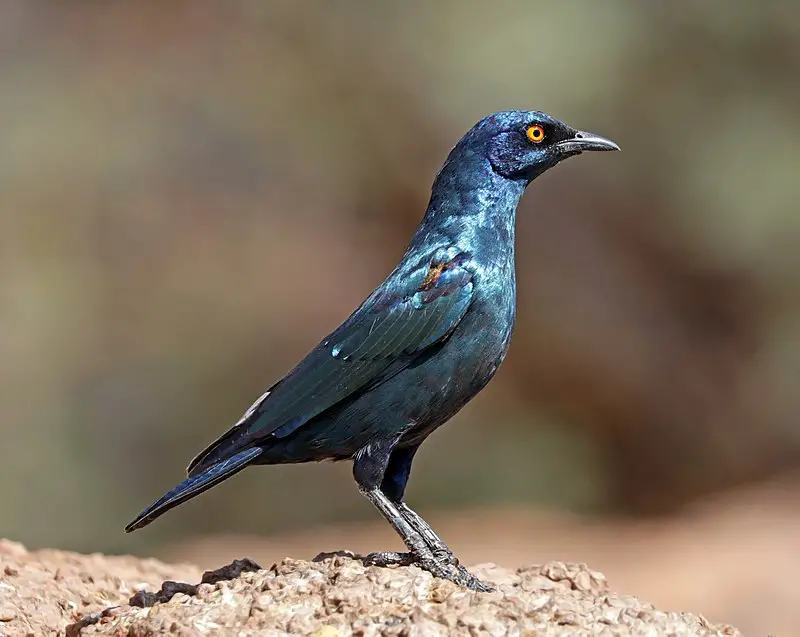
The Cape starling is a species of starling native to Southern Africa, living in woodlands, bushveld and even suburbs. It has two subspecies; the larger ‘L. n. culminator’ having greener wings and tail plumage than its counterpart.
These birds are mainly grey in colour with white spots on their bodies and bright red eyes which make them stand out from other similar-looking species found in the region.
They have long bills for picking up food items such as insects, seeds or berries along with powerful legs for perching upon trees or wires alike – an important trait when it comes to finding shelter during bad weather.
The males also have glossy black heads while females possess pale brown ones; both sexes share common yellow beaks making this bird a beautiful sight indeed.Scientific classification:
| Kingdom | Animalia |
| Phylum | Chordata |
| Class | Aves |
| Order | Passeriformes |
| Family | Sturnidae |
| Genus | Lamprotornis |
| Species | L. nitens |
Also Featured In: Lesotho birds,
34. White-Fronted Plover
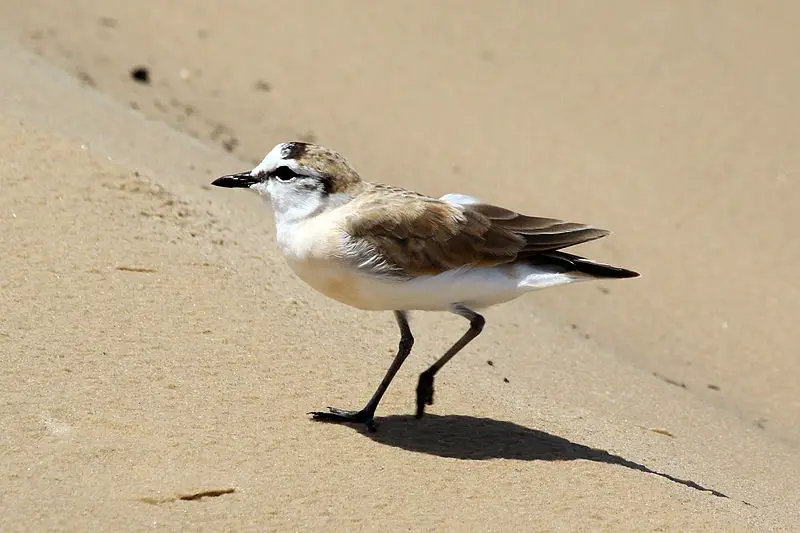
The White-fronted Plover is a small shorebird that inhabits sub-Saharan Africa and Madagascar. It has white feathers on its head and chest with gray wings, brown back, black lower belly and legs.
Its diet consists of insects, crustaceans, mollusks and worms found in the sand or mudflats along coasts or river banks.
The bird’s nesting behavior involves creating shallow scrapes in the ground to lay one to three eggs which are then incubated by both parents for around 24 days before hatching.
This species of plover is monogamous meaning it will form pairs for life as well as being quite long lived with an expected lifespan up to 10 years old.Scientific classification:
| Kingdom | Animalia |
| Phylum | Chordata |
| Class | Aves |
| Order | Charadriiformes |
| Family | Charadriidae |
| Genus | Charadrius |
| Species | C. marginatus |
Also Featured In: Comoros birds,
35. Senegal Lapwing
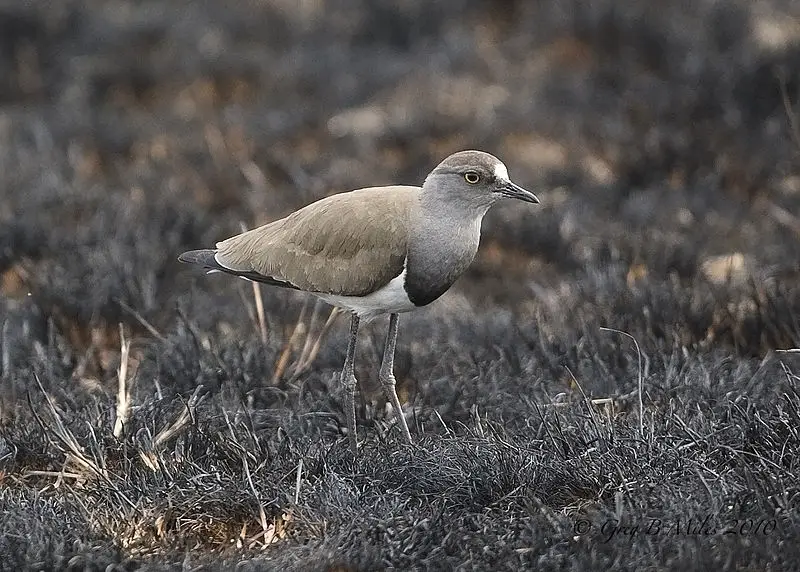
The Senegal Lapwing is a species of wading bird found in many parts of Africa. It has distinctive black wings and white plumage, with yellow-orange legs that help it stand out against its surroundings.
The Senegal Lapwing feeds on small insects, larvae, worms, crustaceans and other invertebrates which they find by probing the ground with their beaks.
They also eat some grains and seeds when available during dry seasons or times of food scarcity.
During breeding season they form large flocks to defend their nests from predators such as snakes, lizards or birds of prey while one adult stays behind to guard the nest at all times until chicks are ready to leave the nest at about three weeks old.Scientific classification:
| Kingdom | Animalia |
| Phylum | Chordata |
| Class | Aves |
| Order | Charadriiformes |
| Family | Charadriidae |
| Genus | Vanellus |
| Species | V. lugubris |
36. Blue Waxbill
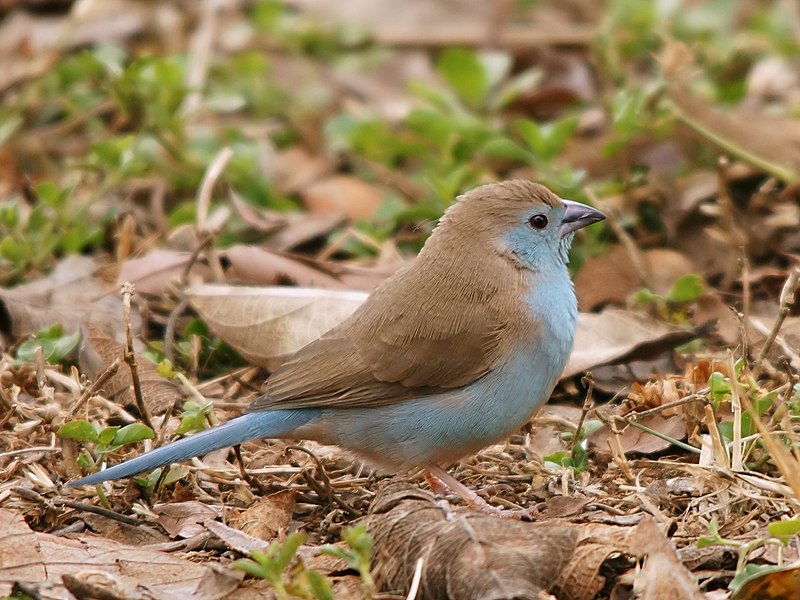
The Blue Waxbill is a species of estrildid finch native to Southern Africa, and it is also quite popular in aviary bird-keeping.
It features blue feathers on its head and throat, as well as a bright orange breast – giving it the “cordon-bleu” name.
This small songbird has an average length of 5 inches long and can be found amongst shrubs or grassland habitats near water sources such as rivers or lakes.
The diet typically consists mainly of seeds supplemented by insects for additional nutrients during breeding season.
They are usually seen in pairs or family groups which become highly territorial during nesting time; they build their nests using fine blades of grass woven together with spider webs.
Despite being heavily hunted by humans for meat consumption purposes, this beautiful bird population continues to thrive today thanks to conservation efforts.Scientific classification:
| Kingdom | Animalia |
| Phylum | Chordata |
| Class | Aves |
| Order | Passeriformes |
| Family | Estrildidae |
| Genus | Uraeginthus |
| Species | U. angolensis |
Also Featured In: Sao Tome & Principe Birds, Blue Birds You’ll Found around Us
37. Violet-Backed Starling
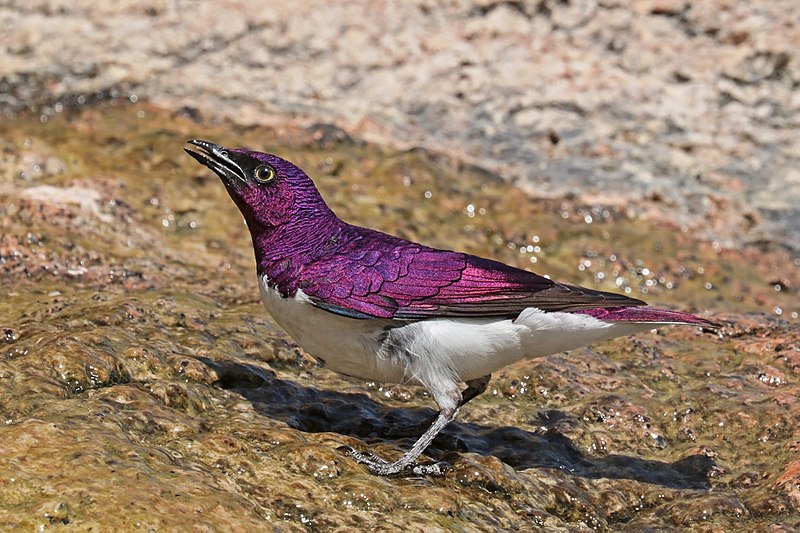
The Violet-backed Starling is a beautiful small bird, with the male sporting a stunning violet back and wings, while the female has an overall grey plumage.
This species of starling can be found in woodlands and savannah forests throughout sub-Saharan Africa.
They are sociable birds that often travel in flocks looking for food such as insects and fruits.
The Violet-backed Starling also forms strong bonds with other members of its flock, so much so that they will even sleep together at night on tree branches to keep warm.
A truly lovely sight to behold if you’re lucky enough to spot one.Scientific classification:
| Kingdom | Animalia |
| Phylum | Chordata |
| Class | Aves |
| Order | Passeriformes |
| Family | Sturnidae |
| Genus | Cinnyricinclus Lesson, 1840 |
| Species | C. leucogaster |
Also Featured In: birds of purple, Savanna Birds You Need to See
38. Brown-Headed Parrot
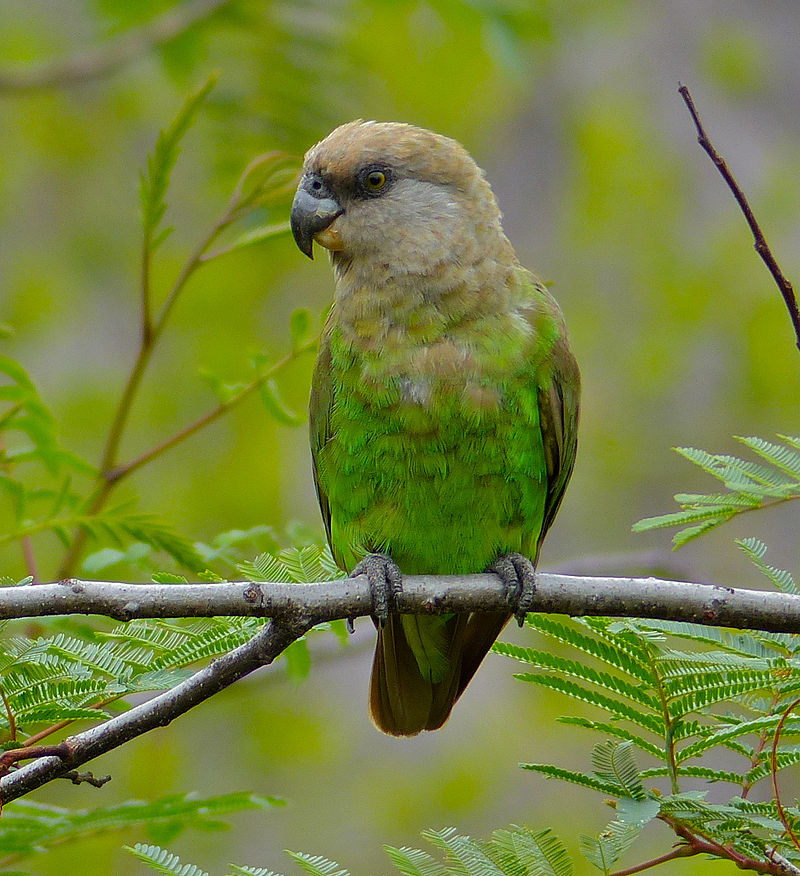
The Brown-headed parrot is a beautiful bird native to South-eastern Africa. It has an overall green plumage, but the wings have bright yellow coverts which inspired its scientific name cryptoxanthus (meaning hidden or concealed yellow).
This small species usually measures around 23 cm in length and weighs between 90 – 120 g.
They are predominantly arboreal birds found living in woodlands, forests and savannas where they can feed on various fruits, seeds and flowers.
These intelligent creatures are often kept as pets because of their ability to mimic human speech.
In addition to this talent they also form strong bonds with their owners making them ideal companions if provided enough mental stimulation through playtime activities like foraging games.Scientific classification:
| Kingdom | Animalia |
| Phylum | Chordata |
| Class | Aves |
| Order | Psittaciformes |
| Family | Psittacidae |
| Genus | Poicephalus |
| Species | P. cryptoxanthus |
Also Featured In: birds of brown,
39. African Fish Eagle
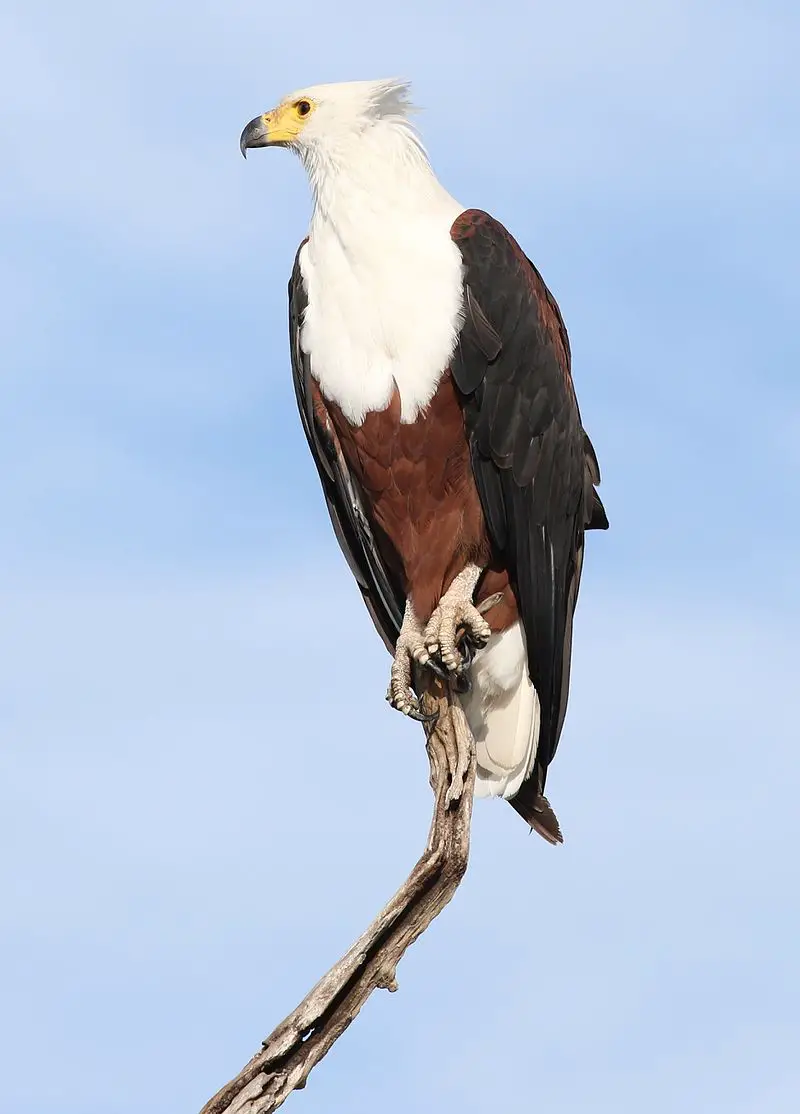
The African fish eagle is a majestic bird of prey found in sub-Saharan Africa near large bodies of water. It is known by many names in different languages due to its extensive range.
This eagle is the national bird of four African countries, including Malawi, Namibia, Zambia, and Zimbabwe.
Its scientific name, Haliaeetus vocifer, is fitting because it has a loud, distinctive call that can be heard from quite a distance.
The African fish eagle’s diet consists mainly of fish, which it swoops down to catch with its talons while in flight.
Its distinctive brown and white plumage, hooked beak, and sharp talons make this a formidable and impressive hunter.
The African fish eagle is an important symbol of African wildlife and is admired by bird watchers and nature enthusiasts for its beauty and strength.Scientific classification:
| Kingdom | Animalia |
| Phylum | Chordata |
| Class | Aves |
| Order | Accipitriformes |
| Family | Accipitridae |
| Genus | Haliaeetus |
| Species | H. vocifer |
Also Featured In: African Birds, East African Birds
40. Crested Barbet
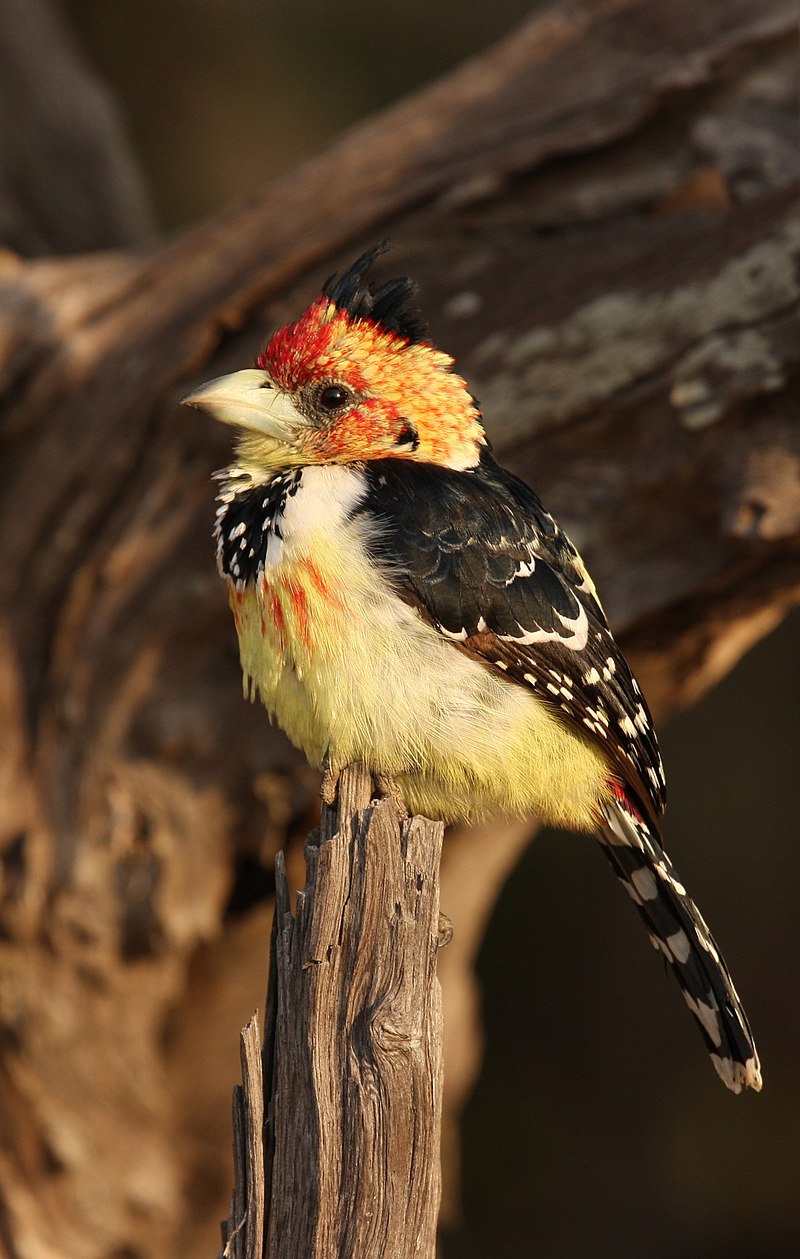
The crested barbet is a sub-Saharan bird with a distinct appearance that includes a thick bill and colourful plumage. Its face is speckled with yellow and red and has a small black crest.
The bird’s belly is a vibrant yellow with hints of red. This small bird is easily recognizable and unique in appearance thanks to its distinct markings.
In Latin, the bird’s name translates to “rough-voiced sound,” which could be a nod to the sound of its call.
Native to the African continent, the crested barbet is a member of the Lybiidae family and is named in honour of a famed French naturalist named François Levaillant.Scientific classification:
| Kingdom | Animalia |
| Phylum | Chordata |
| Class | Aves |
| Order | Piciformes |
| Family | Lybiidae |
| Genus | Trachyphonus |
| Species | T. vaillantii |
41. Arrow-Marked Babbler
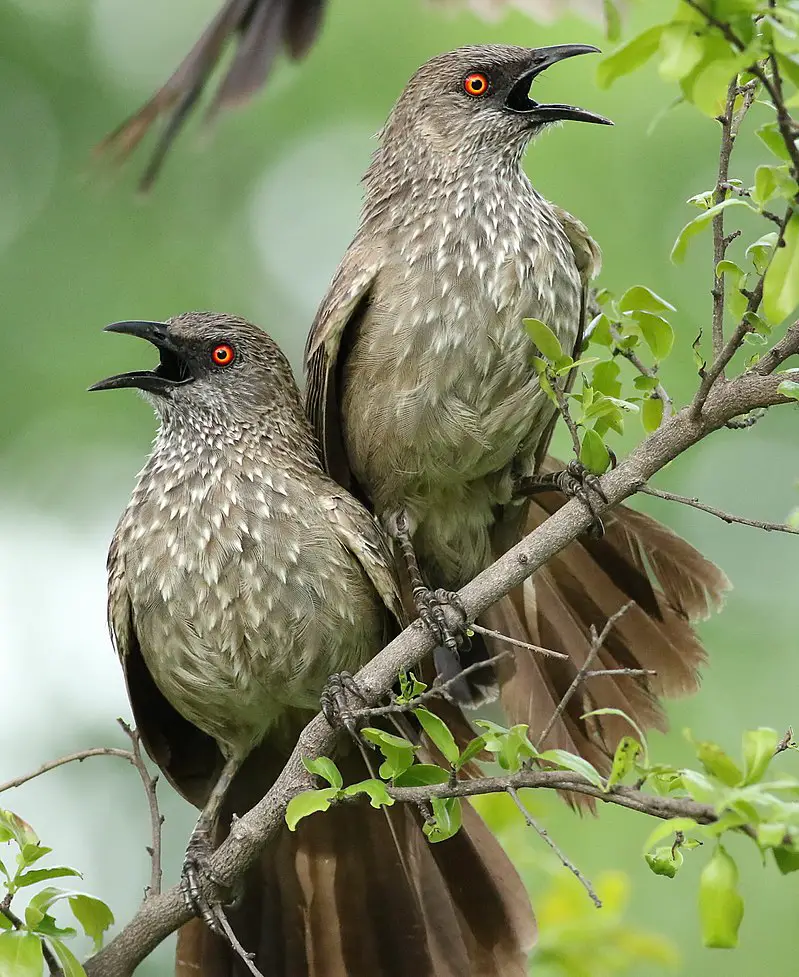
The arrow-marked babbler is a bird species that belongs to the family Leiothrichidae. It is commonly found in woodlands across the southern Afrotropics region including countries such as Angola, Botswana, and South Africa.
The bird is known for its distinct arrow-shaped markings, which gives it its name. It thrives in subtropical or tropical dry forests and is often seen in large groups.
This bird is a native of several African countries, such as Kenya, Malawi, Mozambique, Uganda, and Zimbabwe.
The arrow-marked babbler is a beloved species amongst bird enthusiasts for its unique appearance and is a common sight in its natural habitat.Scientific classification:
| Kingdom | Animalia |
| Phylum | Chordata |
| Class | Aves |
| Order | Passeriformes |
| Family | Leiothrichidae |
| Genus | Turdoides |
| Species | T. jardineii |
42. Greater Blue-Eared Starling
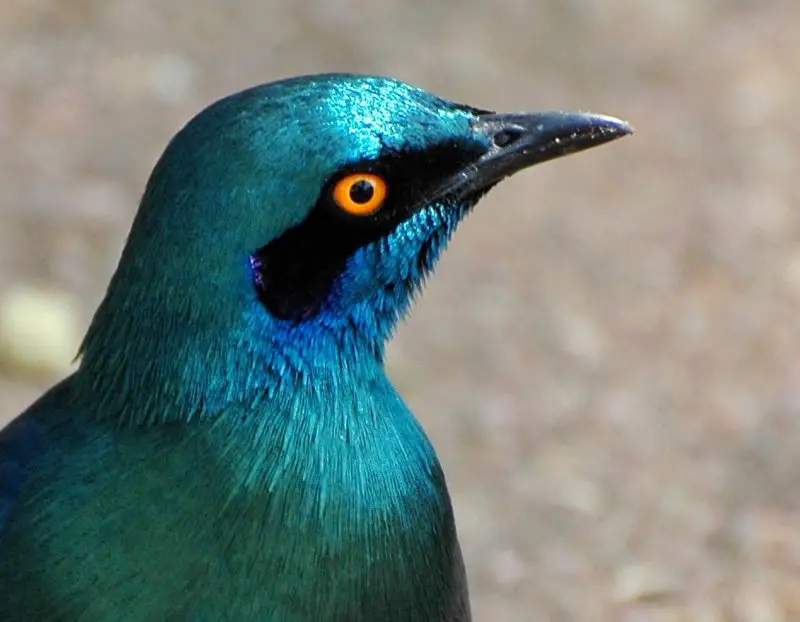
The greater blue-eared starling is a bird commonly found in open woodlands throughout eastern and northeastern Africa. This species breeds in countries like Senegal, Ethiopia, Angola, and South Africa.
It is known for its distinct blue and black feathers, which are glossy in appearance. The bird is approximately 22 cm long and migrates seasonally. It belongs to the Lamprotornis chalybaeus species and has four accepted subspecies.
The greater blue-eared starling is a frequent sight both in the wild and in urban areas, often feeding on insects and fruits.
Its beautiful coloring and distinct vocalizations make it a popular subject for birdwatchers and ornithologists.Scientific classification:
| Kingdom | Animalia |
| Phylum | Chordata |
| Class | Aves |
| Order | Passeriformes |
| Family | Sturnidae |
| Genus | Lamprotornis |
| Species | L. chalybaeus |
43. Brown Snake Eagle
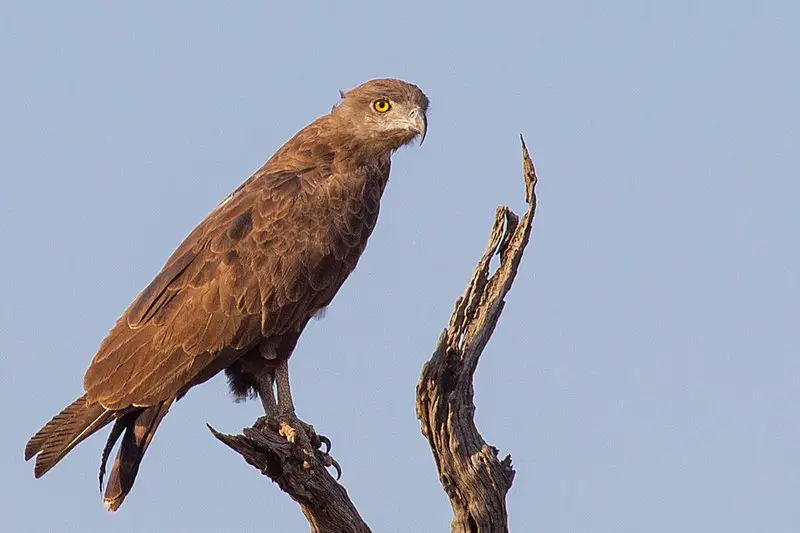
The brown snake eagle is a large bird of prey found in several regions of Africa. It primarily feeds on a variety of snakes, making it an almost obligate predator.
This species is very solitary and has a prolonged breeding cycle, raising only one eaglet at a time. Despite being naturally scarce, the brown snake eagle is classified as a least concern species.Scientific classification:
| Kingdom | Animalia |
| Phylum | Chordata |
| Class | Aves |
| Order | Accipitriformes |
| Family | Accipitridae |
| Genus | Circaetus |
| Species | C. cinereus |
44. Purple Roller
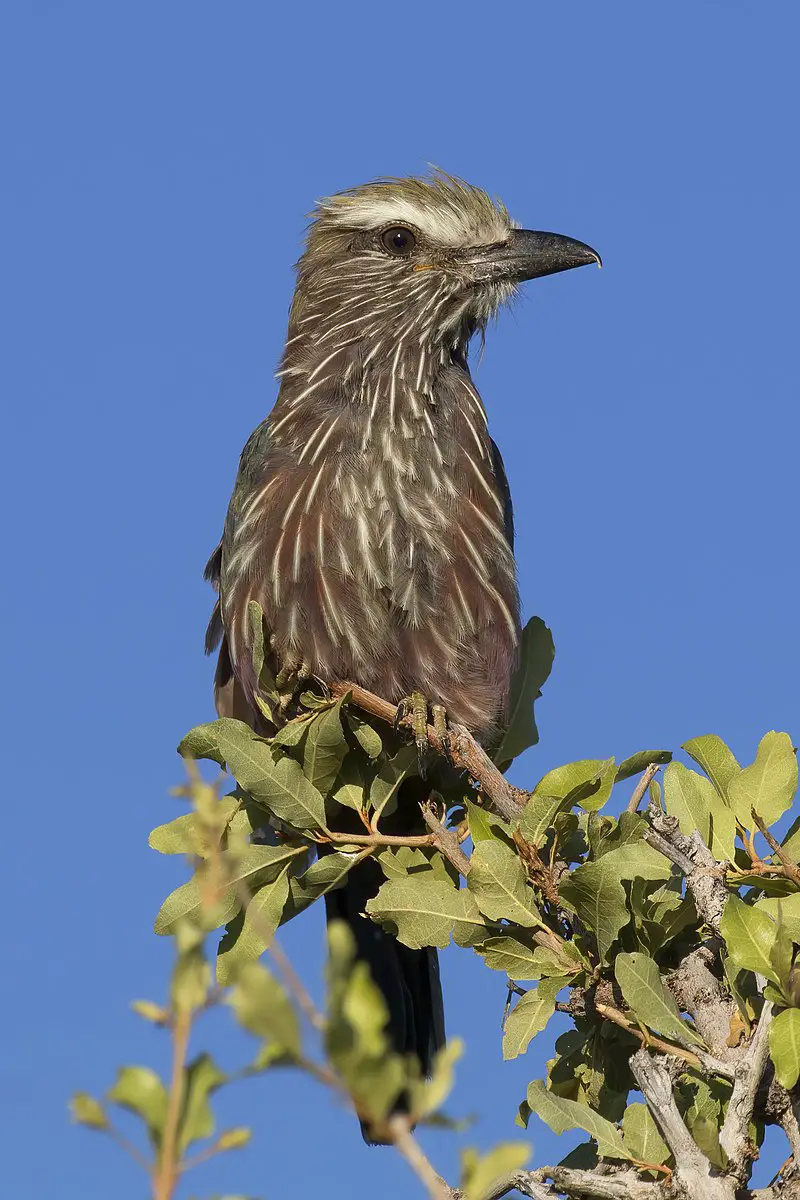
The purple roller, also known as the rufous-crowned roller, is a medium-sized bird found throughout sub-Saharan Africa.
Its appearance is relatively plain compared to other members of the roller family, with dull colors and a harsh, grating voice.
The bird was first described in 1800 by French zoologist François Marie Daudin under the name Coracias naevia, based on a collected specimen.
Despite its unremarkable appearance, the purple roller is a fascinating bird, known for its unique behavior and important role in its ecosystem.
With its widespread distribution, this bird remains an important part of the African avian community.Scientific classification:
| Kingdom | Animalia |
| Phylum | Chordata |
| Class | Aves |
| Order | Coraciiformes |
| Family | Coraciidae |
| Genus | Coracias |
| Species | C. naevius |
Also Featured In: Birds of Etosha National Park,
45. African Spoonbill
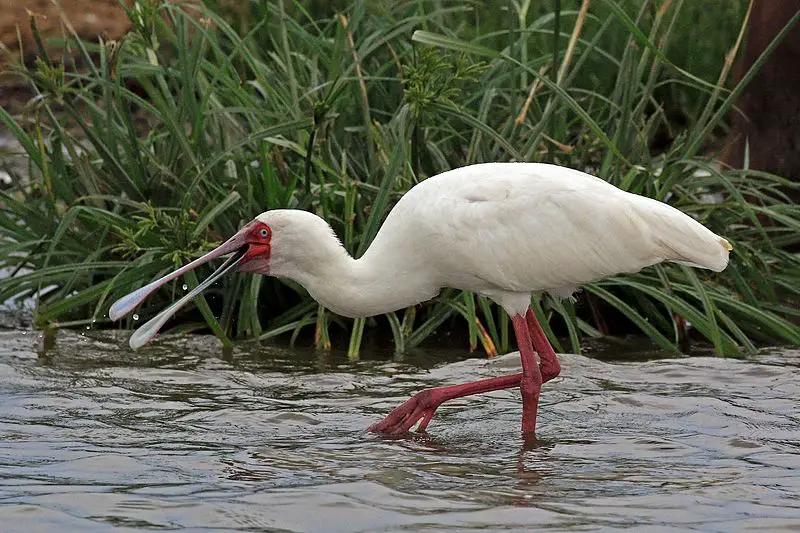
The African spoonbill is a wading bird found in Africa and Madagascar. It has long legs and belongs to the ibis and spoonbill family.
These birds are commonly found in marshy wetlands and prefer areas with shallow water. They typically nest in colonies in trees or reedbeds.
African spoonbills are known to thrive in Botswana, Kenya, Mozambique, Namibia, South Africa, and Zimbabwe. Unlike other birds, they do not share colonies with other species.
The African spoonbill is an elegant bird with a distinctive spoon-shaped bill. It feeds on small fish, invertebrates, and insects.
These birds are also known for their beautiful pink and white plumage, making them a favorite among bird watchers and nature lovers.Scientific classification:
| Kingdom | Animalia |
| Phylum | Chordata |
| Class | Aves |
| Order | Pelecaniformes |
| Family | Threskiornithidae |
| Genus | Platalea |
| Species | P. alba |
Also Featured In: Birds You’ll Find in Kenya Safari,
46. Orange-Winged Pytilia
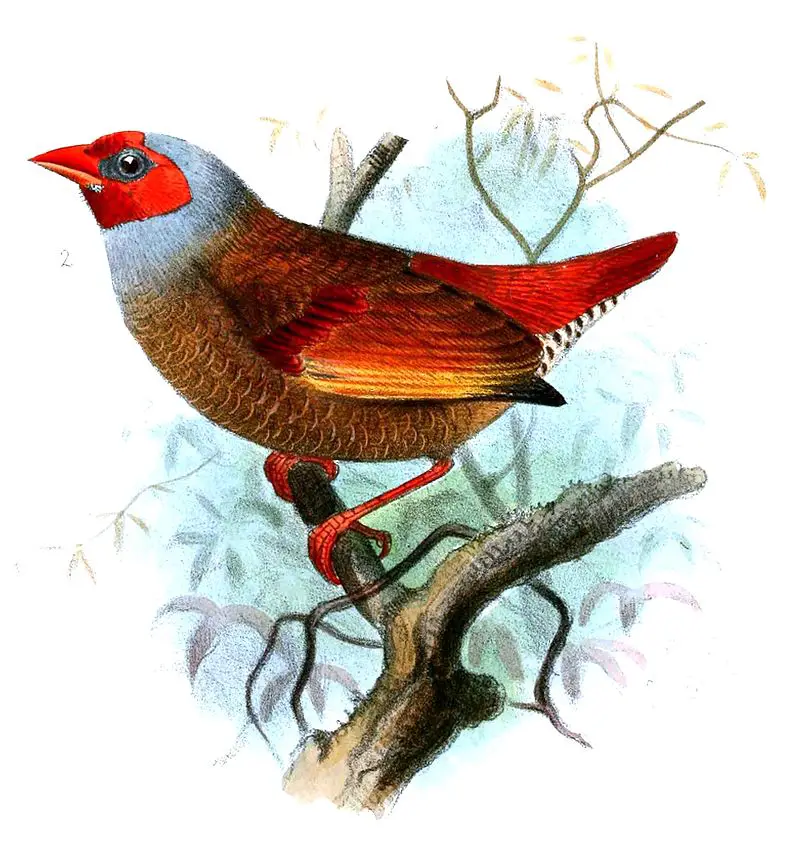
The orange-winged pytilia, also known as the golden-backed pytilia, is a small bird species found in various regions of Africa.
It has been assessed as being of least concern by the International Union for Conservation of Nature, which means that it is not considered to be in danger of extinction.
This bird was first described in 1789 and is the only species in its genus. The average length of the orange-winged pytilia is approximately 11 cm. These birds are known for their distinctive orange wings and golden backs.
They belong to the family of estrildid finches and can be found in a variety of habitats such as grasslands and forests.
Overall, the orange-winged pytilia is a common and relatively unremarkable bird species, but its bright coloration makes it a popular target for birdwatchers and avian enthusiasts.Scientific classification:
| Kingdom | Animalia |
| Phylum | Chordata |
| Class | Aves |
| Order | Passeriformes |
| Family | Estrildidae |
| Genus | Pytilia |
| Species | P. afra |
47. Red-Billed Buffalo Weaver
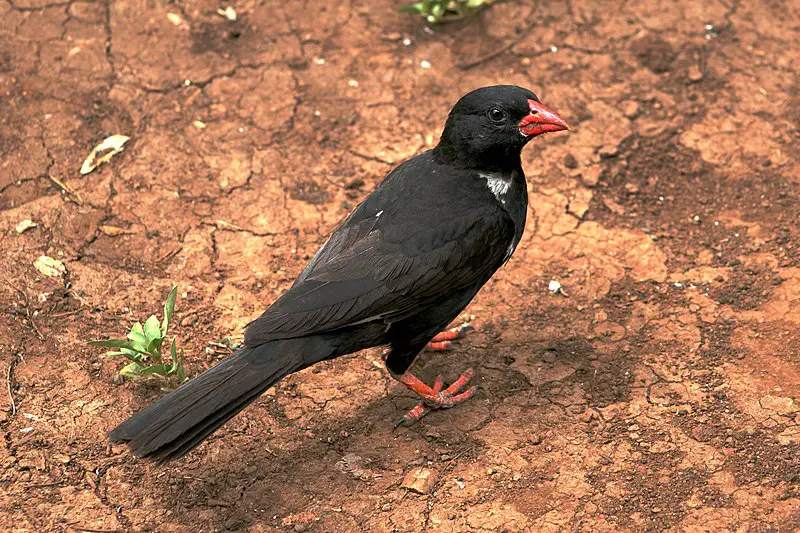
The Red-billed buffalo weaver is a bird species belonging to the Ploceidae family. It inhabits the dry savanna of eastern and southern Africa.
The male of the species weighs an average of 82.1 g while the female weighs around 70.7 g.
It could be the largest of the Ploceidae family. The bird has a length of 21 to 25 cm when fully grown. Its red bill is the distinguishing feature.
The bird has adapted to living in open and arid environments. It feeds mainly on insects, seeds, and fruits.
The Red-billed buffalo weaver is gregarious and often found in flocks. The nest is enormous and shaped like a massive sphere with a side entrance.
It is made of grass and stout twigs, and it often provides nesting sites for several other bird species.Scientific classification:
| Kingdom | Animalia |
| Phylum | Chordata |
| Class | Aves |
| Order | Passeriformes |
| Family | Ploceidae |
| Genus | Bubalornis |
| Species | B. niger |
48. Miombo Wren-Warbler
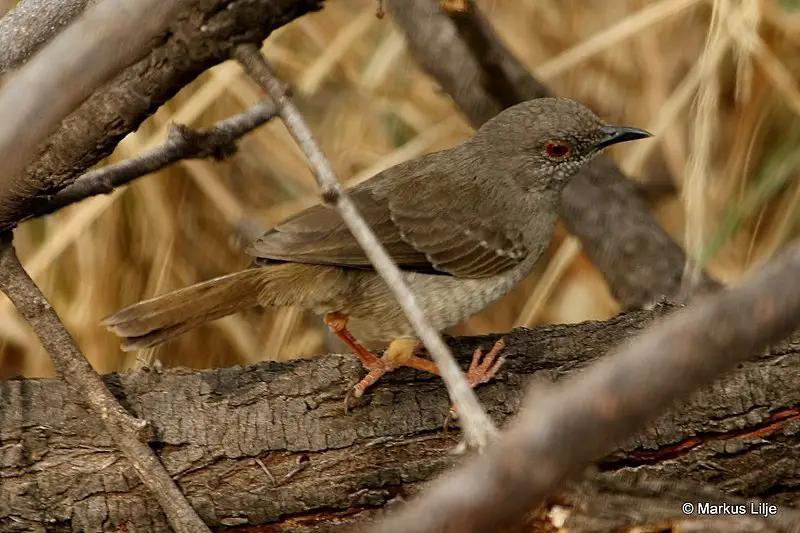
The miombo wren-warbler, commonly found in southern Africa, is a bird belonging to the family Cisticolidae. It is also referred to as the miombo barred warbler or pale wren-warbler.
This species is known for its distinct features, including a striped pattern on its wings and a pale underbelly. The miombo wren-warbler is a small bird primarily found in miombo woodland areas.
Its diet primarily consists of insects and other small invertebrates. This bird is considered to be of least concern in terms of conservation status, but with human activities leading to deforestation, there is a possibility that it might be threatened in the future.Scientific classification:
| Kingdom | Animalia |
| Phylum | Chordata |
| Class | Aves |
| Order | Passeriformes |
| Family | Cisticolidae |
| Genus | Calamonastes |
| Species | C. undosus |
49. Yellow-Billed Duck
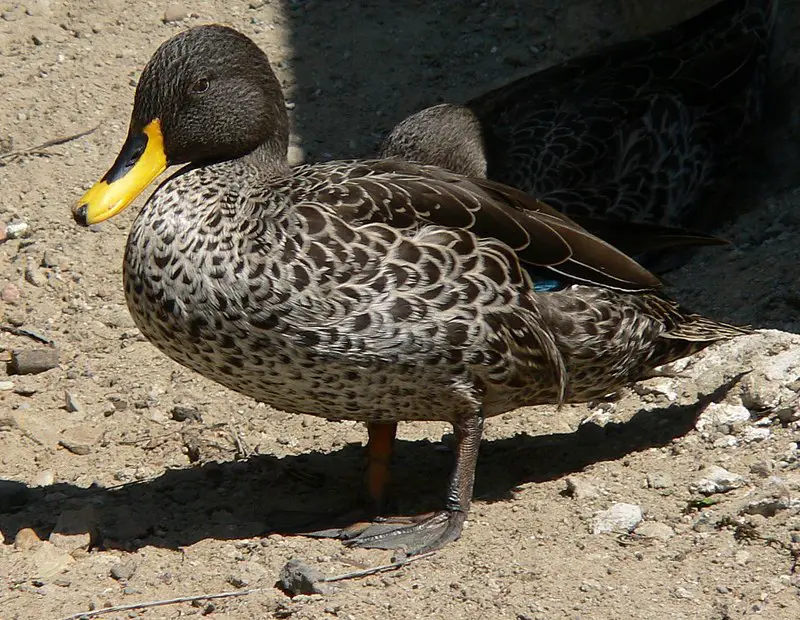
The Yellow-billed duck is a common resident breeder found in Southern and Eastern Africa. It is not a migrating bird but will move around during the dry season to find water.
These ducks are social and often flock together outside of breeding season. They are grey in color with a darker head and a distinguishing bright yellow bill. Their wings are relatively short and they are similar in size to a mallard duck.
The Yellow-billed duck is a dabbling duck and can be found in many types of water habitats.Scientific classification:
| Kingdom | Animalia |
| Phylum | Chordata |
| Class | Aves |
| Order | Anseriformes |
| Family | Anatidae |
| Genus | Anas |
| Species | A. undulata |
50. Arnot’s Chat
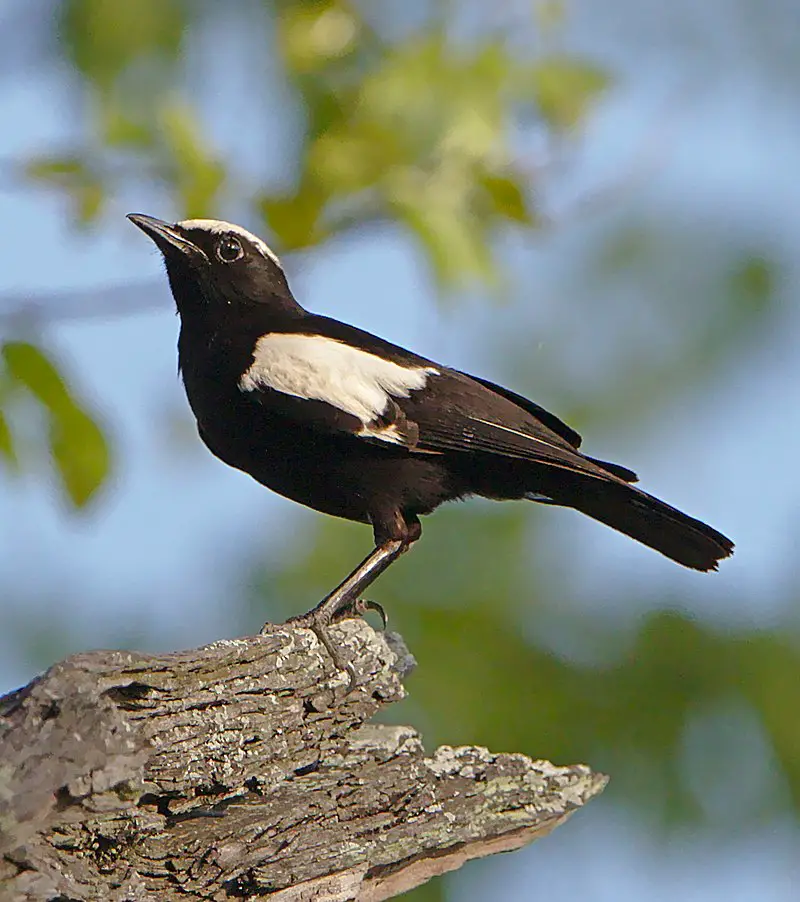
Arnot’s chat, also known as the white-headed black-chat, is a bird species found in southern Africa. It is a part of the chat and flycatcher family Muscicapidae.
The species can be found in countries such as Rwanda, Angola, and South Africa. It was first described by Henry Baker Tristram in 1869, based on a specimen collected in Zimbabwe.
This bird has a white head and a black body, which is where it gets its name. It is a small bird that is commonly found in rocky areas and open woodlands.
Arnot’s chat is a fascinating bird to observe, and its unique appearance is sure to grab the attention of bird enthusiasts in the region.Scientific classification:
| Kingdom | Animalia |
| Phylum | Chordata |
| Class | Aves |
| Order | Passeriformes |
| Family | Muscicapidae |
| Genus | Myrmecocichla |
| Species | M. arnotti |
51. Cape Wagtail
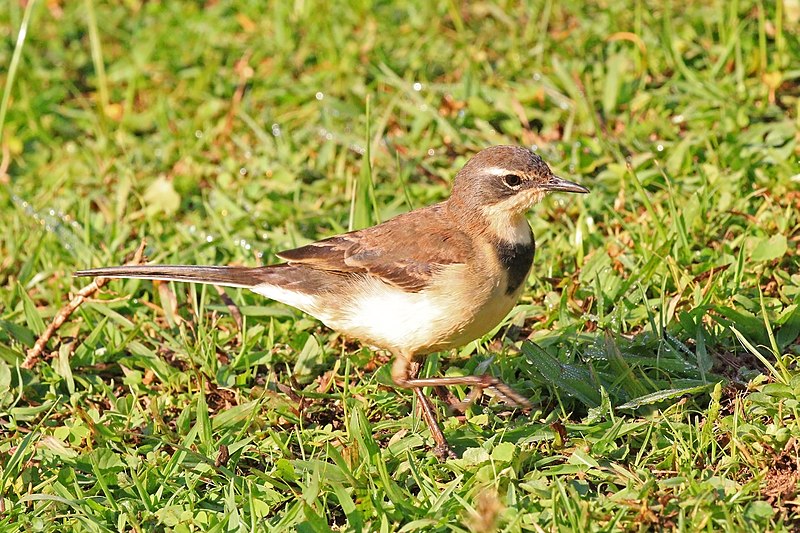
Cape wagtail, also called Wells’s wagtail, is a small insect-eating bird that is common in Southern Africa. They are often seen near water, lawns, and gardens.
These territorial birds usually stay in one place throughout the year, but sometimes they migrate to different altitudes. They also form flocks during the non-breeding season.
Like other wagtails, these small birds belong to the family of passerines. Cape wagtails are charming birds with long tails that they wag up and down when perched or walking on the ground.
They have striking patterns of black and white feathers, with a distinctive yellow forehead.
The Cape wagtail bird is a bright and bustling creature that adds some liveliness to the area it inhabits.Scientific classification:
| Kingdom | Animalia |
| Phylum | Chordata |
| Class | Aves |
| Order | Passeriformes |
| Family | Motacillidae |
| Genus | Motacilla |
| Species | M. capensis |